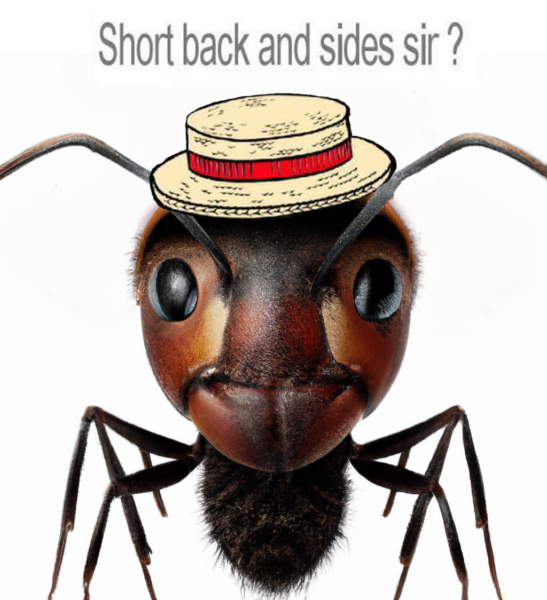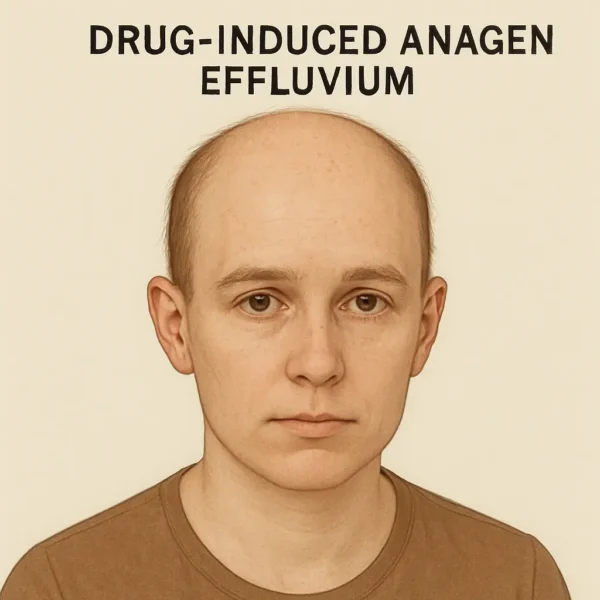Trichotillomania (TTM), colloquially known as a hair-pulling disorder, is a body-focused repetitive behavior (BFRB) characterized by an irresistible urge to pull out one’s hair, resulting in visible hair loss and significant psychological distress. This disorder affects approximately 0.5% to 2.0% of the population, with varying degrees of severity and impact on quality of life. Although recently categorized alongside obsessive-compulsive disorder (OCD) in the DSM-5, trichotillomania appears to exhibit distinct differences in terms of symptomatology and treatment response, necessitating tailored therapeutic approaches.
Historically, treatment of TTM has been a significant clinical challenge, with behavioral and pharmacological therapies demonstrating rather inconsistent efficacy. However, emerging evidence indicates promising results for certain interventions, including habit reversal training (HRT) and the use of specific medications like n-acetyl cysteine and olanzapine.
Habit reversal training is one of the most empirically supported treatments for TTM. This therapy helps individuals become more aware of their pulling behaviors and urges, facilitating the development of alternative, non-harmful responses to these urges. HRT includes awareness training, self-monitoring, stimulus control, and competing response procedures. The ultimate goal is to enable individuals to recognize and manage their pulling urges, avoid situations likely to trigger hair pulling, and adopt alternative behaviors in place of hair pulling. Preliminary evidence suggests that augmenting HRT with mindfulness meditation may further improve its efficacy.
Pharmacotherapy, though not always successful, provides a valuable adjunct to behavioral therapies for many individuals. While no FDA-approved drugs exist specifically for the treatment of TTM, several psychotropic drugs and supplements have shown variable efficacy in managing the symptoms of this disorder.
N-acetyl cysteine (NAC), a glutamate modulator, is one such supplement that has gained attention in recent years for its potential in treating TTM. N-acetyl cysteine (NAC) is a supplement form of the amino acid cysteine. Amino acids are the building blocks of proteins, which are necessary for numerous body functions. NAC has shown promise in reducing compulsive behaviors in BFRB disorders, including TTM, but the evidence thus far is derived from a limited number of clinical trials and case studies with small sample sizes. Therefore, larger, more rigorous trials are needed to fully establish the efficacy of NAC for TTM and other BFRB disorders3
Similarly, there is preliminary evidence to suggest that certain psychotropic medications, such as the tricyclic antidepressant clomipramine and the atypical antipsychotic olanzapine, may be effective in treating TTM. However, the decision to use these medications is made by clinicians on a case-by-case basis, considering the severity of TTM and the nature of psychiatric comorbidity, if present. Also, the side effect profiles of these and similar drugs can limit their practical utility.
In conclusion, the management of TTM remains a complex challenge requiring a multi-faceted approach. Current evidence supports the use of HRT as a primary treatment strategy, with pharmacotherapy options such as NAC, clomipramine, and olanzapine showing potential benefit in certain cases. However, more rigorous research is needed to establish the long-term efficacy of these treatments and to develop new, more effective therapeutic strategies for this condition. Therefore, the field of TTM treatment research remains ripe for exploration, with the potential for significant advancements in understanding and treating this often debilitating condition.
Further research and consultation with healthcare professionals are recommended for a deeper understanding of these and other treatment modalities for trichotillomania.
Bibliography
11711645 {11711645:EQDAR6ZH},{11711645:8BIHX9KV},{11711645:VQA7CATA},{11711645:CXWZ7K67},{11711645:6N46UM4V} 1 vancouver 50 date asc 208 https://www.keratin.com/wp-content/plugins/zotpress/ %7B%22status%22%3A%22success%22%2C%22updateneeded%22%3Afalse%2C%22instance%22%3Afalse%2C%22meta%22%3A%7B%22request_last%22%3A0%2C%22request_next%22%3A0%2C%22used_cache%22%3Atrue%7D%2C%22data%22%3A%5B%7B%22key%22%3A%22EQDAR6ZH%22%2C%22library%22%3A%7B%22id%22%3A11711645%7D%2C%22meta%22%3A%7B%22creatorSummary%22%3A%22Morris%20et%20al.%22%2C%22parsedDate%22%3A%222013-09%22%2C%22numChildren%22%3A0%7D%2C%22bib%22%3A%22%26lt%3Bdiv%20class%3D%26quot%3Bcsl-bib-body%26quot%3B%20style%3D%26quot%3Bline-height%3A%201.35%3B%20%26quot%3B%26gt%3B%5Cn%20%20%26lt%3Bdiv%20class%3D%26quot%3Bcsl-entry%26quot%3B%20style%3D%26quot%3Bclear%3A%20left%3B%20%26quot%3B%26gt%3B%5Cn%20%20%20%20%26lt%3Bdiv%20class%3D%26quot%3Bcsl-left-margin%26quot%3B%20style%3D%26quot%3Bfloat%3A%20left%3B%20padding-right%3A%200.5em%3B%20text-align%3A%20right%3B%20width%3A%201em%3B%26quot%3B%26gt%3B1.%26lt%3B%5C%2Fdiv%26gt%3B%26lt%3Bdiv%20class%3D%26quot%3Bcsl-right-inline%26quot%3B%20style%3D%26quot%3Bmargin%3A%200%20.4em%200%201.5em%3B%26quot%3B%26gt%3BMorris%20SH%2C%20Zickgraf%20HF%2C%20Dingfelder%20HE%2C%20Franklin%20ME.%20Habit%20reversal%20training%20in%20trichotillomania%3A%20guide%20for%20the%20clinician.%20Expert%20Rev%20Neurother.%202013%20Sep%3B13%289%29%3A1069%26%23x2013%3B77.%26lt%3B%5C%2Fdiv%26gt%3B%5Cn%20%20%20%26lt%3B%5C%2Fdiv%26gt%3B%5Cn%26lt%3B%5C%2Fdiv%26gt%3B%22%2C%22data%22%3A%7B%22itemType%22%3A%22journalArticle%22%2C%22title%22%3A%22Habit%20reversal%20training%20in%20trichotillomania%3A%20guide%20for%20the%20clinician%22%2C%22creators%22%3A%5B%7B%22creatorType%22%3A%22author%22%2C%22firstName%22%3A%22Sarah%20H.%22%2C%22lastName%22%3A%22Morris%22%7D%2C%7B%22creatorType%22%3A%22author%22%2C%22firstName%22%3A%22Hana%20F.%22%2C%22lastName%22%3A%22Zickgraf%22%7D%2C%7B%22creatorType%22%3A%22author%22%2C%22firstName%22%3A%22Hilary%20E.%22%2C%22lastName%22%3A%22Dingfelder%22%7D%2C%7B%22creatorType%22%3A%22author%22%2C%22firstName%22%3A%22Martin%20E.%22%2C%22lastName%22%3A%22Franklin%22%7D%5D%2C%22abstractNote%22%3A%22%5Cu5472%5Cu6963%5Cu686f%5Cu7469%5Cu6c6c%5Cu6f6d%5Cu616e%5Cu6961%5Cu2028%5Cu6861%5Cu6972%5Cu2d70%5Cu756c%5Cu6c69%5Cu6e67%5Cu2064%5Cu6973%5Cu6f72%5Cu6465%5Cu7229%5Cu2069%5Cu6e76%5Cu6f6c%5Cu7665%5Cu7320%5Cu7265%5Cu7065%5Cu7469%5Cu7469%5Cu7665%5Cu2068%5Cu6169%5Cu7220%5Cu7075%5Cu6c6c%5Cu696e%5Cu6720%5Cu7468%5Cu6174%5Cu2063%5Cu616e%5Cu2063%5Cu6175%5Cu7365%5Cu2073%5Cu6967%5Cu6e69%5Cu6669%5Cu6361%5Cu6e74%5Cu2064%5Cu6973%5Cu7472%5Cu6573%5Cu7320%5Cu616e%5Cu6420%5Cu696d%5Cu7061%5Cu6972%5Cu6d65%5Cu6e74%5Cu2069%5Cu6e20%5Cu6675%5Cu6e63%5Cu7469%5Cu6f6e%5Cu696e%5Cu672e%5Cu2042%5Cu6f74%5Cu6820%5Cu6368%5Cu696c%5Cu6472%5Cu656e%5Cu2061%5Cu6e64%5Cu2061%5Cu6475%5Cu6c74%5Cu7320%5Cu7375%5Cu6666%5Cu6572%5Cu2066%5Cu726f%5Cu6d20%5Cu7468%5Cu6520%5Cu6469%5Cu736f%5Cu7264%5Cu6572%5Cu2e20%5Cu4861%5Cu6269%5Cu7420%5Cu7265%5Cu7665%5Cu7273%5Cu616c%5Cu2074%5Cu7261%5Cu696e%5Cu696e%5Cu6720%5Cu2848%5Cu5254%5Cu2920%5Cu6973%5Cu2074%5Cu6865%5Cu2074%5Cu7269%5Cu6368%5Cu6f74%5Cu696c%5Cu6c6f%5Cu6d61%5Cu6e69%5Cu6120%5Cu7472%5Cu6561%5Cu746d%5Cu656e%5Cu7420%5Cu7769%5Cu7468%5Cu2074%5Cu6865%5Cu206d%5Cu6f73%5Cu7420%5Cu656d%5Cu7069%5Cu7269%5Cu6361%5Cu6c20%5Cu7375%5Cu7070%5Cu6f72%5Cu742e%5Cu2048%5Cu5254%5Cu2062%5Cu6567%5Cu696e%5Cu7320%5Cu7769%5Cu7468%5Cu2064%5Cu6576%5Cu656c%5Cu6f70%5Cu696e%5Cu6720%5Cu616e%5Cu2069%5Cu6e2d%5Cu6465%5Cu7074%5Cu6820%5Cu756e%5Cu6465%5Cu7273%5Cu7461%5Cu6e64%5Cu696e%5Cu6720%5Cu6f66%5Cu2074%5Cu6865%5Cu2063%5Cu6c69%5Cu656e%5Cu7427%5Cu7320%5Cu756e%5Cu6971%5Cu7565%5Cu2070%5Cu756c%5Cu6c69%5Cu6e67%5Cu2062%5Cu6568%5Cu6176%5Cu696f%5Cu7273%5Cu2e20%5Cu5468%5Cu6520%5Cu6d61%5Cu6a6f%5Cu7220%5Cu636f%5Cu6d70%5Cu6f6e%5Cu656e%5Cu7473%5Cu206f%5Cu6620%5Cu4852%5Cu5420%5Cu6361%5Cu6e20%5Cu7468%5Cu656e%5Cu2062%5Cu6520%5Cu6361%5Cu7272%5Cu6965%5Cu6420%5Cu6f75%5Cu7420%5Cu696e%5Cu2061%5Cu2077%5Cu6179%5Cu2074%5Cu6861%5Cu7420%5Cu7461%5Cu7267%5Cu6574%5Cu7320%5Cu7468%5Cu6520%5Cu636c%5Cu6965%5Cu6e74%5Cu2773%5Cu2073%5Cu7065%5Cu6369%5Cu6669%5Cu6320%5Cu6e65%5Cu6564%5Cu732e%5Cu2054%5Cu6865%5Cu7365%5Cu2069%5Cu6e63%5Cu6c75%5Cu6465%5Cu2061%5Cu7761%5Cu7265%5Cu6e65%5Cu7373%5Cu2074%5Cu7261%5Cu696e%5Cu696e%5Cu6720%5Cu616e%5Cu6420%5Cu7365%5Cu6c66%5Cu2d6d%5Cu6f6e%5Cu6974%5Cu6f72%5Cu696e%5Cu672c%5Cu2073%5Cu7469%5Cu6d75%5Cu6c75%5Cu7320%5Cu636f%5Cu6e74%5Cu726f%5Cu6c20%5Cu616e%5Cu6420%5Cu636f%5Cu6d70%5Cu6574%5Cu696e%5Cu6720%5Cu7265%5Cu7370%5Cu6f6e%5Cu7365%5Cu2070%5Cu726f%5Cu6365%5Cu6475%5Cu7265%5Cu732e%5Cu2057%5Cu6974%5Cu6869%5Cu6e20%5Cu6561%5Cu6368%5Cu206f%5Cu6620%5Cu7468%5Cu6573%5Cu6520%5Cu636f%5Cu6d70%5Cu6f6e%5Cu656e%5Cu7473%5Cu2074%5Cu6865%5Cu2063%5Cu6c69%5Cu656e%5Cu7420%5Cu6c65%5Cu6172%5Cu6e73%5Cu2074%5Cu6f20%5Cu7265%5Cu636f%5Cu676e%5Cu697a%5Cu6520%5Cu6869%5Cu7320%5Cu6f72%5Cu2068%5Cu6572%5Cu2070%5Cu756c%5Cu6c69%5Cu6e67%5Cu2075%5Cu7267%5Cu6573%5Cu2c20%5Cu6176%5Cu6f69%5Cu6420%5Cu7369%5Cu7475%5Cu6174%5Cu696f%5Cu6e73%5Cu2069%5Cu6e20%5Cu7768%5Cu6963%5Cu6820%5Cu7075%5Cu6c6c%5Cu696e%5Cu6720%5Cu6973%5Cu206d%5Cu6f72%5Cu6520%5Cu6c69%5Cu6b65%5Cu6c79%5Cu2061%5Cu6e64%5Cu2061%5Cu646f%5Cu7074%5Cu2062%5Cu6568%5Cu6176%5Cu696f%5Cu7273%5Cu2074%5Cu6861%5Cu7420%5Cu6361%5Cu6e20%5Cu6265%5Cu2075%5Cu7365%5Cu6420%5Cu696e%5Cu7374%5Cu6561%5Cu6420%5Cu6f66%5Cu2070%5Cu756c%5Cu6c69%5Cu6e67%5Cu2e20%5Cu4675%5Cu7475%5Cu7265%5Cu2077%5Cu6f72%5Cu6b20%5Cu7769%5Cu6c6c%5Cu2069%5Cu6e76%5Cu6f6c%5Cu7665%5Cu2065%5Cu7661%5Cu6c75%5Cu6174%5Cu696e%5Cu6720%5Cu7468%5Cu6520%5Cu6566%5Cu6669%5Cu6361%5Cu6379%5Cu206f%5Cu6620%5Cu6164%5Cu6469%5Cu6e67%5Cu2074%5Cu6865%5Cu7261%5Cu7079%5Cu206d%5Cu6f64%5Cu656c%5Cu7320%5Cu7375%5Cu6368%5Cu2061%5Cu7320%5Cu6d69%5Cu6e64%5Cu6675%5Cu6c6e%5Cu6573%5Cu7320%5Cu6d65%5Cu6469%5Cu7461%5Cu7469%5Cu6f6e%5Cu2069%5Cu6e20%5Cu6f72%5Cu6465%5Cu7220%5Cu746f%5Cu2066%5Cu7572%5Cu7468%5Cu6572%5Cu2065%5Cu6e68%5Cu616e%5Cu6365%5Cu2074%5Cu6865%5Cu2065%5Cu6666%5Cu6563%5Cu7469%5Cu7665%5Cu6e65%5Cu7373%5Cu206f%5Cu6620%5Cu4852%5Cu542c%5Cu2061%5Cu6e64%5Cu2073%5Cu7475%5Cu6479%5Cu696e%5Cu6720%5Cu7468%5Cu6520%5Cu6c6f%5Cu6e67%5Cu2d74%5Cu6572%5Cu6d20%5Cu6566%5Cu6669%5Cu6361%5Cu6379%5Cu206f%5Cu6620%5Cu4852%5Cu5420%5Cu666f%5Cu7220%5Cu6368%5Cu696c%5Cu6472%5Cu656e%5Cu2061%5Cu6e64%5Cu2061%5Cu6475%5Cu6c74%5Cu732e%22%2C%22date%22%3A%222013-09%22%2C%22language%22%3A%22eng%22%2C%22DOI%22%3A%2210.1586%5C%2F14737175.2013.827477%22%2C%22ISSN%22%3A%221744-8360%22%2C%22url%22%3A%22%22%2C%22collections%22%3A%5B%22U7IBB3BH%22%5D%2C%22dateModified%22%3A%222023-06-19T14%3A48%3A13Z%22%7D%7D%2C%7B%22key%22%3A%22VQA7CATA%22%2C%22library%22%3A%7B%22id%22%3A11711645%7D%2C%22meta%22%3A%7B%22creatorSummary%22%3A%22Baczynski%20and%20Sharma%22%2C%22parsedDate%22%3A%222020-08%22%2C%22numChildren%22%3A0%7D%2C%22bib%22%3A%22%26lt%3Bdiv%20class%3D%26quot%3Bcsl-bib-body%26quot%3B%20style%3D%26quot%3Bline-height%3A%201.35%3B%20%26quot%3B%26gt%3B%5Cn%20%20%26lt%3Bdiv%20class%3D%26quot%3Bcsl-entry%26quot%3B%20style%3D%26quot%3Bclear%3A%20left%3B%20%26quot%3B%26gt%3B%5Cn%20%20%20%20%26lt%3Bdiv%20class%3D%26quot%3Bcsl-left-margin%26quot%3B%20style%3D%26quot%3Bfloat%3A%20left%3B%20padding-right%3A%200.5em%3B%20text-align%3A%20right%3B%20width%3A%201em%3B%26quot%3B%26gt%3B1.%26lt%3B%5C%2Fdiv%26gt%3B%26lt%3Bdiv%20class%3D%26quot%3Bcsl-right-inline%26quot%3B%20style%3D%26quot%3Bmargin%3A%200%20.4em%200%201.5em%3B%26quot%3B%26gt%3BBaczynski%20C%2C%20Sharma%20V.%20Pharmacotherapy%20for%20trichotillomania%20in%20adults.%20Expert%20Opin%20Pharmacother.%202020%20Aug%3B21%2812%29%3A1455%26%23x2013%3B66.%26lt%3B%5C%2Fdiv%26gt%3B%5Cn%20%20%20%26lt%3B%5C%2Fdiv%26gt%3B%5Cn%26lt%3B%5C%2Fdiv%26gt%3B%22%2C%22data%22%3A%7B%22itemType%22%3A%22journalArticle%22%2C%22title%22%3A%22Pharmacotherapy%20for%20trichotillomania%20in%20adults%22%2C%22creators%22%3A%5B%7B%22creatorType%22%3A%22author%22%2C%22firstName%22%3A%22Christine%22%2C%22lastName%22%3A%22Baczynski%22%7D%2C%7B%22creatorType%22%3A%22author%22%2C%22firstName%22%3A%22Verinder%22%2C%22lastName%22%3A%22Sharma%22%7D%5D%2C%22abstractNote%22%3A%22%5Cu494e%5Cu5452%5Cu4f44%5Cu5543%5Cu5449%5Cu4f4e%5Cu3a20%5Cu4375%5Cu7272%5Cu656e%5Cu746c%5Cu7920%5Cu636f%5Cu6e63%5Cu6570%5Cu7475%5Cu616c%5Cu697a%5Cu6564%5Cu2061%5Cu7320%5Cu616e%5Cu206f%5Cu6273%5Cu6573%5Cu7369%5Cu7665%5Cu2063%5Cu6f6d%5Cu7075%5Cu6c73%5Cu6976%5Cu6520%5Cu616e%5Cu6420%5Cu7265%5Cu6c61%5Cu7465%5Cu6420%5Cu6469%5Cu736f%5Cu7264%5Cu6572%5Cu2c20%5Cu7472%5Cu6963%5Cu686f%5Cu7469%5Cu6c6c%5Cu6f6d%5Cu616e%5Cu6961%5Cu2c20%5Cu6f72%5Cu2068%5Cu6169%5Cu722d%5Cu7075%5Cu6c6c%5Cu696e%5Cu6720%5Cu6469%5Cu736f%5Cu7264%5Cu6572%5Cu2c20%5Cu6973%5Cu2061%5Cu2063%5Cu6f6d%5Cu6d6f%5Cu6e20%5Cu696c%5Cu6c6e%5Cu6573%5Cu7320%5Cu7468%5Cu6174%5Cu2063%5Cu6175%5Cu7365%5Cu7320%5Cu7369%5Cu676e%5Cu6966%5Cu6963%5Cu616e%5Cu7420%5Cu6469%5Cu7374%5Cu7265%5Cu7373%5Cu206f%5Cu7220%5Cu6675%5Cu6e63%5Cu7469%5Cu6f6e%5Cu616c%5Cu2069%5Cu6d70%5Cu6169%5Cu726d%5Cu656e%5Cu7473%5Cu2069%5Cu6e20%5Cu7661%5Cu7269%5Cu6f75%5Cu7320%5Cu6c69%5Cu6665%5Cu2064%5Cu6f6d%5Cu6169%5Cu6e73%5Cu2e20%5Cu4d6f%5Cu7374%5Cu2069%5Cu6e64%5Cu6976%5Cu6964%5Cu7561%5Cu6c73%5Cu2077%5Cu6974%5Cu6820%5Cu7472%5Cu6963%5Cu686f%5Cu7469%5Cu6c6c%5Cu6f6d%5Cu616e%5Cu6961%5Cu2061%5Cu6c73%5Cu6f20%5Cu6861%5Cu7665%5Cu206f%5Cu7468%5Cu6572%5Cu2063%5Cu6f6d%5Cu6f72%5Cu6269%5Cu6420%5Cu6469%5Cu6167%5Cu6e6f%5Cu7365%5Cu732e%5Cu2054%5Cu7265%5Cu6174%5Cu696e%5Cu6720%5Cu7472%5Cu6963%5Cu686f%5Cu7469%5Cu6c6c%5Cu6f6d%5Cu616e%5Cu6961%5Cu2077%5Cu6974%5Cu6820%5Cu7068%5Cu6172%5Cu6d61%5Cu636f%5Cu7468%5Cu6572%5Cu6170%5Cu7920%5Cu6973%5Cu2063%5Cu6f6d%5Cu706c%5Cu6963%5Cu6174%5Cu6564%5Cu2073%5Cu696e%5Cu6365%5Cu2074%5Cu6865%5Cu7265%5Cu2061%5Cu7265%5Cu2063%5Cu7572%5Cu7265%5Cu6e74%5Cu6c79%5Cu206e%5Cu6f20%5Cu4644%5Cu412d%5Cu6170%5Cu7072%5Cu6f76%5Cu6564%5Cu2064%5Cu7275%5Cu6773%5Cu2066%5Cu6f72%5Cu2069%5Cu7473%5Cu2074%5Cu7265%5Cu6174%5Cu6d65%5Cu6e74%5Cu2e0a%5Cu4152%5Cu4541%5Cu5320%5Cu434f%5Cu5645%5Cu5245%5Cu443a%5Cu2054%5Cu6865%5Cu2064%5Cu6174%5Cu6162%5Cu6173%5Cu6573%5Cu2050%5Cu7562%5Cu4d65%5Cu642c%5Cu2050%5Cu7379%5Cu6368%5Cu494e%5Cu464f%5Cu2c20%5Cu4349%5Cu4e41%5Cu484c%5Cu2c20%5Cu4576%5Cu6964%5Cu656e%5Cu6365%5Cu2d62%5Cu6173%5Cu6564%5Cu204d%5Cu6564%5Cu6963%5Cu696e%5Cu6520%5Cu5265%5Cu7669%5Cu6577%5Cu732c%5Cu2061%5Cu6e64%5Cu2043%5Cu6f63%5Cu6872%5Cu616e%5Cu6520%5Cu4461%5Cu7461%5Cu6261%5Cu7365%5Cu206f%5Cu6620%5Cu5379%5Cu7374%5Cu656d%5Cu6174%5Cu6963%5Cu2052%5Cu6576%5Cu6965%5Cu7773%5Cu2077%5Cu6572%5Cu6520%5Cu7365%5Cu6172%5Cu6368%5Cu6564%5Cu2c20%5Cu7969%5Cu656c%5Cu6469%5Cu6e67%5Cu2061%5Cu2074%5Cu6f74%5Cu616c%5Cu206f%5Cu6620%5Cu3130%5Cu206f%5Cu7065%5Cu6e20%5Cu7472%5Cu6961%5Cu6c73%5Cu2061%5Cu6e64%5Cu2031%5Cu3020%5Cu636f%5Cu6e74%5Cu726f%5Cu6c6c%5Cu6564%5Cu2074%5Cu7269%5Cu616c%5Cu7320%5Cu7365%5Cu6c65%5Cu6374%5Cu6564%5Cu2e20%5Cu5468%5Cu6973%5Cu2072%5Cu6576%5Cu6965%5Cu7720%5Cu6169%5Cu6d73%5Cu2074%5Cu6f20%5Cu6578%5Cu616d%5Cu696e%5Cu6520%5Cu7068%5Cu6172%5Cu6d61%5Cu636f%5Cu7468%5Cu6572%5Cu6170%5Cu6575%5Cu7469%5Cu6320%5Cu6f70%5Cu7469%5Cu6f6e%5Cu7320%5Cu666f%5Cu7220%5Cu7468%5Cu6520%5Cu7472%5Cu6561%5Cu746d%5Cu656e%5Cu7420%5Cu6f66%5Cu2074%5Cu7269%5Cu6368%5Cu6f74%5Cu696c%5Cu6c6f%5Cu6d61%5Cu6e69%5Cu6120%5Cu696e%5Cu2061%5Cu6475%5Cu6c74%5Cu7320%5Cu616e%5Cu6420%5Cu6d61%5Cu6b65%5Cu7320%5Cu7265%5Cu636f%5Cu6d6d%5Cu656e%5Cu6461%5Cu7469%5Cu6f6e%5Cu7320%5Cu666f%5Cu7220%5Cu7468%5Cu6520%5Cu6173%5Cu7365%5Cu7373%5Cu6d65%5Cu6e74%5Cu2061%5Cu6e64%5Cu206d%5Cu616e%5Cu6167%5Cu656d%5Cu656e%5Cu7420%5Cu6f66%5Cu2074%5Cu6865%5Cu2064%5Cu6973%5Cu6f72%5Cu6465%5Cu722e%5Cu0a45%5Cu5850%5Cu4552%5Cu5420%5Cu4f50%5Cu494e%5Cu494f%5Cu4e3a%5Cu2054%5Cu6865%5Cu7265%5Cu2069%5Cu7320%5Cu7072%5Cu656c%5Cu696d%5Cu696e%5Cu6172%5Cu7920%5Cu6576%5Cu6964%5Cu656e%5Cu6365%5Cu2074%5Cu6861%5Cu7420%5Cu636c%5Cu6f6d%5Cu6970%5Cu7261%5Cu6d69%5Cu6e65%5Cu2c20%5Cu6f6c%5Cu616e%5Cu7a61%5Cu7069%5Cu6e65%5Cu2c20%5Cu616e%5Cu6420%5Cu4e2d%5Cu6163%5Cu6574%5Cu796c%5Cu6379%5Cu7374%5Cu6569%5Cu6e65%5Cu206d%5Cu6179%5Cu2062%5Cu6520%5Cu6566%5Cu6665%5Cu6374%5Cu6976%5Cu6520%5Cu696e%5Cu2063%5Cu6173%5Cu6573%5Cu206f%5Cu6620%5Cu7472%5Cu6963%5Cu686f%5Cu7469%5Cu6c6c%5Cu6f6d%5Cu616e%5Cu6961%5Cu2c20%5Cu686f%5Cu7765%5Cu7665%5Cu722c%5Cu2067%5Cu6976%5Cu656e%5Cu2074%5Cu6865%5Cu2070%5Cu6175%5Cu6369%5Cu7479%5Cu206f%5Cu6620%5Cu636f%5Cu6e74%5Cu726f%5Cu6c6c%5Cu6564%5Cu2073%5Cu7475%5Cu6469%5Cu6573%5Cu2077%5Cu6974%5Cu6820%5Cu6c61%5Cu7267%5Cu6520%5Cu7361%5Cu6d70%5Cu6c65%5Cu2073%5Cu697a%5Cu6573%5Cu2c20%5Cu6465%5Cu6369%5Cu7369%5Cu6f6e%5Cu7320%5Cu7265%5Cu6761%5Cu7264%5Cu696e%5Cu6720%5Cu7468%5Cu6520%5Cu7573%5Cu6520%5Cu6f66%5Cu2064%5Cu7275%5Cu6773%5Cu2073%5Cu686f%5Cu756c%5Cu6420%5Cu6265%5Cu206d%5Cu6164%5Cu6520%5Cu6f6e%5Cu2061%5Cu2063%5Cu6173%5Cu652d%5Cu6279%5Cu2d63%5Cu6173%5Cu6520%5Cu6261%5Cu7369%5Cu7320%5Cu7461%5Cu6b69%5Cu6e67%5Cu2069%5Cu6e74%5Cu6f20%5Cu6163%5Cu636f%5Cu756e%5Cu7420%5Cu7468%5Cu6520%5Cu7365%5Cu7665%5Cu7269%5Cu7479%5Cu206f%5Cu6620%5Cu7472%5Cu6963%5Cu686f%5Cu7469%5Cu6c6c%5Cu6f6d%5Cu616e%5Cu6961%5Cu2061%5Cu6e64%5Cu2074%5Cu6865%5Cu206e%5Cu6174%5Cu7572%5Cu6520%5Cu6f66%5Cu2070%5Cu7379%5Cu6368%5Cu6961%5Cu7472%5Cu6963%5Cu2063%5Cu6f6d%5Cu6f72%5Cu6269%5Cu6469%5Cu7479%3F%22%2C%22date%22%3A%222020-08%22%2C%22language%22%3A%22eng%22%2C%22DOI%22%3A%2210.1080%5C%2F14656566.2020.1761324%22%2C%22ISSN%22%3A%221744-7666%22%2C%22url%22%3A%22%22%2C%22collections%22%3A%5B%22U7IBB3BH%22%5D%2C%22dateModified%22%3A%222023-06-19T14%3A49%3A30Z%22%7D%7D%2C%7B%22key%22%3A%22CXWZ7K67%22%2C%22library%22%3A%7B%22id%22%3A11711645%7D%2C%22meta%22%3A%7B%22creatorSummary%22%3A%22Everett%20et%20al.%22%2C%22parsedDate%22%3A%222020-11%22%2C%22numChildren%22%3A0%7D%2C%22bib%22%3A%22%26lt%3Bdiv%20class%3D%26quot%3Bcsl-bib-body%26quot%3B%20style%3D%26quot%3Bline-height%3A%201.35%3B%20%26quot%3B%26gt%3B%5Cn%20%20%26lt%3Bdiv%20class%3D%26quot%3Bcsl-entry%26quot%3B%20style%3D%26quot%3Bclear%3A%20left%3B%20%26quot%3B%26gt%3B%5Cn%20%20%20%20%26lt%3Bdiv%20class%3D%26quot%3Bcsl-left-margin%26quot%3B%20style%3D%26quot%3Bfloat%3A%20left%3B%20padding-right%3A%200.5em%3B%20text-align%3A%20right%3B%20width%3A%201em%3B%26quot%3B%26gt%3B1.%26lt%3B%5C%2Fdiv%26gt%3B%26lt%3Bdiv%20class%3D%26quot%3Bcsl-right-inline%26quot%3B%20style%3D%26quot%3Bmargin%3A%200%20.4em%200%201.5em%3B%26quot%3B%26gt%3BEverett%20GJ%2C%20Jafferany%20M%2C%20Skurya%20J.%20Recent%20advances%20in%20the%20treatment%20of%20trichotillomania%20%28hair-pulling%20disorder%29.%20Dermatol%20Ther.%202020%20Nov%3B33%286%29%3Ae13818.%26lt%3B%5C%2Fdiv%26gt%3B%5Cn%20%20%20%26lt%3B%5C%2Fdiv%26gt%3B%5Cn%26lt%3B%5C%2Fdiv%26gt%3B%22%2C%22data%22%3A%7B%22itemType%22%3A%22journalArticle%22%2C%22title%22%3A%22Recent%20advances%20in%20the%20treatment%20of%20trichotillomania%20%28hair-pulling%20disorder%29%22%2C%22creators%22%3A%5B%7B%22creatorType%22%3A%22author%22%2C%22firstName%22%3A%22Gregory%20J.%22%2C%22lastName%22%3A%22Everett%22%7D%2C%7B%22creatorType%22%3A%22author%22%2C%22firstName%22%3A%22Mohammad%22%2C%22lastName%22%3A%22Jafferany%22%7D%2C%7B%22creatorType%22%3A%22author%22%2C%22firstName%22%3A%22Jonathon%22%2C%22lastName%22%3A%22Skurya%22%7D%5D%2C%22abstractNote%22%3A%22%5Cu5472%5Cu6963%5Cu686f%5Cu7469%5Cu6c6c%5Cu6f6d%5Cu616e%5Cu6961%5Cu2028%5Cu5454%5Cu4d29%5Cu2069%5Cu7320%5Cu6120%5Cu636f%5Cu6e64%5Cu6974%5Cu696f%5Cu6e20%5Cu696e%5Cu2077%5Cu6869%5Cu6368%5Cu2061%5Cu6666%5Cu6563%5Cu7465%5Cu6420%5Cu696e%5Cu6469%5Cu7669%5Cu6475%5Cu616c%5Cu7320%5Cu7075%5Cu6c6c%5Cu206f%5Cu7574%5Cu2074%5Cu6865%5Cu6972%5Cu2068%5Cu6169%5Cu7220%5Cu7265%5Cu7375%5Cu6c74%5Cu696e%5Cu6720%5Cu696e%5Cu2068%5Cu6169%5Cu7220%5Cu6c6f%5Cu7373%5Cu2e20%5Cu5468%5Cu6973%5Cu2064%5Cu6973%5Cu6f72%5Cu6465%5Cu7220%5Cu6166%5Cu6665%5Cu6374%5Cu7320%5Cu726f%5Cu7567%5Cu686c%5Cu7920%5Cu302e%5Cu3525%5Cu2074%5Cu6f20%5Cu322e%5Cu3025%5Cu206f%5Cu6620%5Cu7468%5Cu6520%5Cu706f%5Cu7075%5Cu6c61%5Cu7469%5Cu6f6e%5Cu2061%5Cu6e64%5Cu2063%5Cu616e%5Cu2068%5Cu6176%5Cu6520%5Cu7369%5Cu676e%5Cu6966%5Cu6963%5Cu616e%5Cu7420%5Cu7073%5Cu7963%5Cu686f%5Cu6c6f%5Cu6769%5Cu6361%5Cu6c20%5Cu6d6f%5Cu7262%5Cu6964%5Cu6974%5Cu792e%5Cu2042%5Cu6568%5Cu6176%5Cu696f%5Cu7261%5Cu6c20%5Cu7468%5Cu6572%5Cu6170%5Cu7920%5Cu6861%5Cu7320%5Cu6265%5Cu656e%5Cu2075%5Cu7365%5Cu6420%5Cu7769%5Cu7468%5Cu2073%5Cu7563%5Cu6365%5Cu7373%5Cu2069%5Cu6e20%5Cu7468%5Cu6520%5Cu7472%5Cu6561%5Cu746d%5Cu656e%5Cu7420%5Cu6f66%5Cu2054%5Cu544d%5Cu2c20%5Cu6275%5Cu7420%5Cu6e6f%5Cu7420%5Cu616c%5Cu6c20%5Cu7061%5Cu7469%5Cu656e%5Cu7473%5Cu2061%5Cu7265%5Cu2077%5Cu696c%5Cu6c69%5Cu6e67%5Cu206f%5Cu7220%5Cu6162%5Cu6c65%5Cu2074%5Cu6f20%5Cu636f%5Cu6d70%5Cu6c79%5Cu2077%5Cu6974%5Cu6820%5Cu7468%5Cu6973%5Cu2074%5Cu7265%5Cu6174%5Cu6d65%5Cu6e74%5Cu2073%5Cu7472%5Cu6174%5Cu6567%5Cu792e%5Cu2054%5Cu6865%5Cu7265%5Cu2069%5Cu7320%5Cu6120%5Cu6e65%5Cu6564%5Cu2066%5Cu6f72%5Cu2065%5Cu6666%5Cu6563%5Cu7469%5Cu7665%5Cu2070%5Cu6861%5Cu726d%5Cu6163%5Cu6f6c%5Cu6f67%5Cu6963%5Cu616c%5Cu2074%5Cu7265%5Cu6174%5Cu6d65%5Cu6e74%5Cu206f%5Cu7074%5Cu696f%5Cu6e73%5Cu2e20%5Cu4869%5Cu7374%5Cu6f72%5Cu6963%5Cu616c%5Cu6c79%5Cu2c20%5Cu7068%5Cu6172%5Cu6d61%5Cu636f%5Cu7468%5Cu6572%5Cu6170%5Cu7920%5Cu666f%5Cu7220%5Cu5454%5Cu4d20%5Cu6861%5Cu7320%5Cu6265%5Cu656e%5Cu2069%5Cu6e61%5Cu6465%5Cu7175%5Cu6174%5Cu6520%5Cu696e%5Cu206d%5Cu6f73%5Cu7420%5Cu6361%5Cu7365%5Cu732c%5Cu2062%5Cu7574%5Cu2072%5Cu6563%5Cu656e%5Cu7420%5Cu6164%5Cu7661%5Cu6e63%5Cu6573%5Cu2068%5Cu6176%5Cu6520%5Cu6265%5Cu656e%5Cu206d%5Cu6164%5Cu6520%5Cu696e%5Cu2074%5Cu6869%5Cu7320%5Cu7265%5Cu6761%5Cu7264%5Cu2e20%5Cu466c%5Cu756f%5Cu7865%5Cu7469%5Cu6e65%5Cu2c20%5Cu636c%5Cu6f6d%5Cu6970%5Cu7261%5Cu6d69%5Cu6e65%5Cu2c20%5Cu6f6c%5Cu616e%5Cu7a61%5Cu7069%5Cu6e65%5Cu2c20%5Cu616e%5Cu6420%5Cu6e61%5Cu6c74%5Cu7265%5Cu786f%5Cu6e65%5Cu2068%5Cu6176%5Cu6520%5Cu616c%5Cu6c20%5Cu6265%5Cu656e%5Cu2075%5Cu7365%5Cu6420%5Cu696e%5Cu2074%5Cu6865%5Cu2074%5Cu7265%5Cu6174%5Cu6d65%5Cu6e74%5Cu206f%5Cu6620%5Cu5454%5Cu4d2c%5Cu2062%5Cu7574%5Cu2065%5Cu7669%5Cu6465%5Cu6e63%5Cu6520%5Cu6f66%5Cu2062%5Cu656e%5Cu6566%5Cu6974%5Cu2068%5Cu6173%5Cu2076%5Cu6172%5Cu6965%5Cu642c%5Cu2061%5Cu6e64%5Cu2073%5Cu6964%5Cu6520%5Cu6566%5Cu6665%5Cu6374%5Cu2070%5Cu726f%5Cu6669%5Cu6c65%5Cu7320%5Cu6361%5Cu6e20%5Cu6c69%5Cu6d69%5Cu7420%5Cu7072%5Cu6163%5Cu7469%5Cu6361%5Cu6c20%5Cu7574%5Cu696c%5Cu6974%5Cu792e%5Cu2052%5Cu6563%5Cu656e%5Cu7420%5Cu6164%5Cu7661%5Cu6e63%5Cu6573%5Cu2069%5Cu6e20%5Cu7468%5Cu6520%5Cu756e%5Cu6465%5Cu7273%5Cu7461%5Cu6e64%5Cu696e%5Cu6720%5Cu6f66%5Cu2074%5Cu6865%5Cu2070%5Cu6174%5Cu686f%5Cu7068%5Cu7973%5Cu696f%5Cu6c6f%5Cu6779%5Cu206f%5Cu6620%5Cu5454%5Cu4d2c%5Cu2061%5Cu7320%5Cu7765%5Cu6c6c%5Cu2061%5Cu7320%5Cu6576%5Cu6964%5Cu656e%5Cu6365%5Cu206f%5Cu6620%5Cu6265%5Cu6e65%5Cu6669%5Cu7420%5Cu7365%5Cu656e%5Cu2077%5Cu6974%5Cu6820%5Cu736f%5Cu6d65%5Cu2067%5Cu6c75%5Cu7461%5Cu6d61%5Cu7465%5Cu2d6d%5Cu6f64%5Cu756c%5Cu6174%5Cu696e%5Cu6720%5Cu6167%5Cu656e%5Cu7473%5Cu2073%5Cu7563%5Cu6820%5Cu6173%5Cu204e%5Cu2d61%5Cu6365%5Cu7479%5Cu6c63%5Cu7973%5Cu7465%5Cu696e%5Cu6520%5Cu616e%5Cu6420%5Cu6472%5Cu6f6e%5Cu6162%5Cu696e%5Cu6f6c%5Cu2c20%5Cu6861%5Cu7665%5Cu2070%5Cu726f%5Cu7669%5Cu6465%5Cu6420%5Cu6e65%5Cu7765%5Cu7220%5Cu706f%5Cu7465%5Cu6e74%5Cu6961%5Cu6c20%5Cu7068%5Cu6172%5Cu6d61%5Cu636f%5Cu7468%5Cu6572%5Cu6170%5Cu7920%5Cu6f70%5Cu7469%5Cu6f6e%5Cu732e%22%2C%22date%22%3A%222020-11%22%2C%22language%22%3A%22eng%22%2C%22DOI%22%3A%2210.1111%5C%2Fdth.13818%22%2C%22ISSN%22%3A%221529-8019%22%2C%22url%22%3A%22%22%2C%22collections%22%3A%5B%22U7IBB3BH%22%5D%2C%22dateModified%22%3A%222023-06-08T21%3A00%3A28Z%22%7D%7D%2C%7B%22key%22%3A%228BIHX9KV%22%2C%22library%22%3A%7B%22id%22%3A11711645%7D%2C%22meta%22%3A%7B%22creatorSummary%22%3A%22Hoffman%20et%20al.%22%2C%22parsedDate%22%3A%222021-09-28%22%2C%22numChildren%22%3A0%7D%2C%22bib%22%3A%22%26lt%3Bdiv%20class%3D%26quot%3Bcsl-bib-body%26quot%3B%20style%3D%26quot%3Bline-height%3A%201.35%3B%20%26quot%3B%26gt%3B%5Cn%20%20%26lt%3Bdiv%20class%3D%26quot%3Bcsl-entry%26quot%3B%20style%3D%26quot%3Bclear%3A%20left%3B%20%26quot%3B%26gt%3B%5Cn%20%20%20%20%26lt%3Bdiv%20class%3D%26quot%3Bcsl-left-margin%26quot%3B%20style%3D%26quot%3Bfloat%3A%20left%3B%20padding-right%3A%200.5em%3B%20text-align%3A%20right%3B%20width%3A%201em%3B%26quot%3B%26gt%3B1.%26lt%3B%5C%2Fdiv%26gt%3B%26lt%3Bdiv%20class%3D%26quot%3Bcsl-right-inline%26quot%3B%20style%3D%26quot%3Bmargin%3A%200%20.4em%200%201.5em%3B%26quot%3B%26gt%3BHoffman%20J%2C%20Williams%20T%2C%20Rothbart%20R%2C%20Ipser%20JC%2C%20Fineberg%20N%2C%20Chamberlain%20SR%2C%20et%20al.%20Pharmacotherapy%20for%20trichotillomania.%20Cochrane%20Database%20Syst%20Rev.%202021%20Sep%2028%3B9%289%29%3ACD007662.%26lt%3B%5C%2Fdiv%26gt%3B%5Cn%20%20%20%26lt%3B%5C%2Fdiv%26gt%3B%5Cn%26lt%3B%5C%2Fdiv%26gt%3B%22%2C%22data%22%3A%7B%22itemType%22%3A%22journalArticle%22%2C%22title%22%3A%22Pharmacotherapy%20for%20trichotillomania%22%2C%22creators%22%3A%5B%7B%22creatorType%22%3A%22author%22%2C%22firstName%22%3A%22Jacob%22%2C%22lastName%22%3A%22Hoffman%22%7D%2C%7B%22creatorType%22%3A%22author%22%2C%22firstName%22%3A%22Taryn%22%2C%22lastName%22%3A%22Williams%22%7D%2C%7B%22creatorType%22%3A%22author%22%2C%22firstName%22%3A%22Rachel%22%2C%22lastName%22%3A%22Rothbart%22%7D%2C%7B%22creatorType%22%3A%22author%22%2C%22firstName%22%3A%22Jonathan%20C.%22%2C%22lastName%22%3A%22Ipser%22%7D%2C%7B%22creatorType%22%3A%22author%22%2C%22firstName%22%3A%22Naomi%22%2C%22lastName%22%3A%22Fineberg%22%7D%2C%7B%22creatorType%22%3A%22author%22%2C%22firstName%22%3A%22Samuel%20R.%22%2C%22lastName%22%3A%22Chamberlain%22%7D%2C%7B%22creatorType%22%3A%22author%22%2C%22firstName%22%3A%22Dan%20J.%22%2C%22lastName%22%3A%22Stein%22%7D%5D%2C%22abstractNote%22%3A%22%5Cu4241%5Cu434b%5Cu4752%5Cu4f55%5Cu4e44%5Cu3a20%5Cu5472%5Cu6963%5Cu686f%5Cu7469%5Cu6c6c%5Cu6f6d%5Cu616e%5Cu6961%5Cu2028%5Cu5454%5Cu4d3b%5Cu2068%5Cu6169%5Cu722d%5Cu7075%5Cu6c6c%5Cu696e%5Cu6720%5Cu6469%5Cu736f%5Cu7264%5Cu6572%5Cu2920%5Cu6973%5Cu2061%5Cu2070%5Cu7265%5Cu7661%5Cu6c65%5Cu6e74%5Cu2061%5Cu6e64%5Cu2064%5Cu6973%5Cu6162%5Cu6c69%5Cu6e67%5Cu2064%5Cu6973%5Cu6f72%5Cu6465%5Cu7220%5Cu6368%5Cu6172%5Cu6163%5Cu7465%5Cu7269%5Cu7365%5Cu6420%5Cu6279%5Cu2072%5Cu6563%5Cu7572%5Cu7265%5Cu6e74%5Cu2068%5Cu6169%5Cu722d%5Cu7075%5Cu6c6c%5Cu696e%5Cu672e%5Cu2048%5Cu6572%5Cu6520%5Cu7765%5Cu2075%5Cu7064%5Cu6174%5Cu6520%5Cu6120%5Cu7072%5Cu6576%5Cu696f%5Cu7573%5Cu2043%5Cu6f63%5Cu6872%5Cu616e%5Cu6520%5Cu5265%5Cu7669%5Cu6577%5Cu206f%5Cu6e20%5Cu7468%5Cu6520%5Cu6566%5Cu6665%5Cu6374%5Cu7320%5Cu6f66%5Cu206d%5Cu6564%5Cu6963%5Cu6174%5Cu696f%5Cu6e20%5Cu666f%5Cu7220%5Cu5454%5Cu4d2e%5Cu0a4f%5Cu424a%5Cu4543%5Cu5449%5Cu5645%5Cu533a%5Cu2054%5Cu6f20%5Cu6173%5Cu7365%5Cu7373%5Cu2074%5Cu6865%5Cu2065%5Cu6666%5Cu6563%5Cu7473%5Cu206f%5Cu6620%5Cu6d65%5Cu6469%5Cu6361%5Cu7469%5Cu6f6e%5Cu2066%5Cu6f72%5Cu2074%5Cu7269%5Cu6368%5Cu6f74%5Cu696c%5Cu6c6f%5Cu6d61%5Cu6e69%5Cu6120%5Cu2854%5Cu544d%5Cu2920%5Cu696e%5Cu2061%5Cu6475%5Cu6c74%5Cu732c%5Cu2063%5Cu6869%5Cu6c64%5Cu7265%5Cu6e20%5Cu616e%5Cu6420%5Cu6164%5Cu6f6c%5Cu6573%5Cu6365%5Cu6e74%5Cu7320%5Cu636f%5Cu6d70%5Cu6172%5Cu6564%5Cu2077%5Cu6974%5Cu6820%5Cu706c%5Cu6163%5Cu6562%5Cu6f20%5Cu6f72%5Cu206f%5Cu7468%5Cu6572%5Cu206d%5Cu6564%5Cu6963%5Cu6174%5Cu696f%5Cu6e2e%5Cu0a53%5Cu4541%5Cu5243%5Cu4820%5Cu4d45%5Cu5448%5Cu4f44%5Cu533a%5Cu2057%5Cu6520%5Cu7365%5Cu6172%5Cu6368%5Cu6564%5Cu2043%5Cu454e%5Cu5452%5Cu414c%5Cu2c20%5Cu4d45%5Cu444c%5Cu494e%5Cu452c%5Cu2045%5Cu6d62%5Cu6173%5Cu652c%5Cu2050%5Cu7379%5Cu6349%5Cu4e46%5Cu4f2c%5Cu2065%5Cu6c65%5Cu7665%5Cu6e20%5Cu6f74%5Cu6865%5Cu7220%5Cu6269%5Cu626c%5Cu696f%5Cu6772%5Cu6170%5Cu6869%5Cu6320%5Cu6461%5Cu7461%5Cu6261%5Cu7365%5Cu732c%5Cu2074%5Cu7269%5Cu616c%5Cu2072%5Cu6567%5Cu6973%5Cu7472%5Cu6965%5Cu7320%5Cu616e%5Cu6420%5Cu6772%5Cu6579%5Cu206c%5Cu6974%5Cu6572%5Cu6174%5Cu7572%5Cu6520%5Cu736f%5Cu7572%5Cu6365%5Cu7320%5Cu2874%5Cu6f20%5Cu3236%5Cu204e%5Cu6f76%5Cu656d%5Cu6265%5Cu7220%5Cu3230%5Cu3230%5Cu292e%5Cu2057%5Cu6520%5Cu6368%5Cu6563%5Cu6b65%5Cu6420%5Cu7265%5Cu6665%5Cu7265%5Cu6e63%5Cu6520%5Cu6c69%5Cu7374%5Cu7320%5Cu616e%5Cu6420%5Cu636f%5Cu6e74%5Cu6163%5Cu7465%5Cu6420%5Cu7375%5Cu626a%5Cu6563%5Cu7420%5Cu6578%5Cu7065%5Cu7274%5Cu732e%5Cu0a53%5Cu454c%5Cu4543%5Cu5449%5Cu4f4e%5Cu2043%5Cu5249%5Cu5445%5Cu5249%5Cu413a%5Cu2057%5Cu6520%5Cu7365%5Cu6c65%5Cu6374%5Cu6564%5Cu2072%5Cu616e%5Cu646f%5Cu6d69%5Cu7365%5Cu6420%5Cu636f%5Cu6e74%5Cu726f%5Cu6c6c%5Cu6564%5Cu2074%5Cu7269%5Cu616c%5Cu7320%5Cu6f66%5Cu206d%5Cu6564%5Cu6963%5Cu6174%5Cu696f%5Cu6e20%5Cu7665%5Cu7273%5Cu7573%5Cu2070%5Cu6c61%5Cu6365%5Cu626f%5Cu206f%5Cu7220%5Cu6f74%5Cu6865%5Cu7220%5Cu6d65%5Cu6469%5Cu6361%5Cu7469%5Cu6f6e%5Cu2066%5Cu6f72%5Cu2054%5Cu544d%5Cu2069%5Cu6e20%5Cu6164%5Cu756c%5Cu7473%5Cu2c20%5Cu6368%5Cu696c%5Cu6472%5Cu656e%5Cu2061%5Cu6e64%5Cu2061%5Cu646f%5Cu6c65%5Cu7363%5Cu656e%5Cu7473%5Cu2e0a%5Cu4441%5Cu5441%5Cu2043%5Cu4f4c%5Cu4c45%5Cu4354%5Cu494f%5Cu4e20%5Cu414e%5Cu4420%5Cu414e%5Cu414c%5Cu5953%5Cu4953%5Cu3a20%5Cu5765%5Cu2075%5Cu7365%5Cu6420%5Cu7374%5Cu616e%5Cu6461%5Cu7264%5Cu206d%5Cu6574%5Cu686f%5Cu646f%5Cu6c6f%5Cu6769%5Cu6361%5Cu6c20%5Cu7072%5Cu6f63%5Cu6564%5Cu7572%5Cu6573%5Cu2065%5Cu7870%5Cu6563%5Cu7465%5Cu6420%5Cu6279%5Cu2043%5Cu6f63%5Cu6872%5Cu616e%5Cu652e%5Cu0a4d%5Cu4149%5Cu4e20%5Cu5245%5Cu5355%5Cu4c54%5Cu533a%5Cu2054%5Cu7765%5Cu6c76%5Cu6520%5Cu7374%5Cu7564%5Cu6965%5Cu7320%5Cu7765%5Cu7265%5Cu2069%5Cu6e63%5Cu6c75%5Cu6465%5Cu642e%5Cu2057%5Cu6520%5Cu6964%5Cu656e%5Cu7469%5Cu6669%5Cu6564%5Cu2031%5Cu3020%5Cu7374%5Cu7564%5Cu6965%5Cu7320%5Cu696e%5Cu2061%5Cu6475%5Cu6c74%5Cu7320%5Cu2832%5Cu3836%5Cu2070%5Cu6172%5Cu7469%5Cu6369%5Cu7061%5Cu6e74%5Cu7329%5Cu2077%5Cu6974%5Cu6820%5Cu6120%5Cu6d65%5Cu616e%5Cu2073%5Cu616d%5Cu706c%5Cu6520%5Cu7369%5Cu7a65%5Cu206f%5Cu6620%5Cu3239%5Cu2070%5Cu6172%5Cu7469%5Cu6369%5Cu7061%5Cu6e74%5Cu7320%5Cu7065%5Cu7220%5Cu7472%5Cu6961%5Cu6c3b%5Cu206f%5Cu6e65%5Cu2073%5Cu7475%5Cu6479%5Cu2069%5Cu6e20%5Cu6368%5Cu696c%5Cu6472%5Cu656e%5Cu2061%5Cu6e64%5Cu2061%5Cu646f%5Cu6c65%5Cu7363%5Cu656e%5Cu7473%5Cu2028%5Cu3339%5Cu2070%5Cu6172%5Cu7469%5Cu6369%5Cu7061%5Cu6e74%5Cu7329%5Cu3b20%5Cu616e%5Cu642c%5Cu206f%5Cu6e65%5Cu2073%5Cu7475%5Cu6479%5Cu2069%5Cu6e20%5Cu6164%5Cu756c%5Cu7473%5Cu2061%5Cu6e64%5Cu2061%5Cu646f%5Cu6c65%5Cu7363%5Cu656e%5Cu7473%5Cu2028%5Cu3232%5Cu2070%5Cu6172%5Cu7469%5Cu6369%5Cu7061%5Cu6e74%5Cu733a%5Cu2031%5Cu3820%5Cu6164%5Cu756c%5Cu7473%5Cu2061%5Cu6e64%5Cu2034%5Cu2061%5Cu646f%5Cu6c65%5Cu7363%5Cu656e%5Cu7473%5Cu292e%5Cu2041%5Cu6c6c%5Cu2073%5Cu7475%5Cu6469%5Cu6573%5Cu2077%5Cu6572%5Cu6520%5Cu7369%5Cu6e67%5Cu6c65%5Cu2d63%5Cu656e%5Cu7472%5Cu652c%5Cu206f%5Cu7574%5Cu7061%5Cu7469%5Cu656e%5Cu7420%5Cu7472%5Cu6961%5Cu6c73%5Cu2e20%5Cu456c%5Cu6576%5Cu656e%5Cu2073%5Cu7475%5Cu6469%5Cu6573%5Cu2063%5Cu6f6d%5Cu7061%5Cu7265%5Cu6420%5Cu6d65%5Cu6469%5Cu6361%5Cu7469%5Cu6f6e%5Cu2061%5Cu6e64%5Cu2070%5Cu6c61%5Cu6365%5Cu626f%5Cu2028%5Cu3333%5Cu3420%5Cu7061%5Cu7274%5Cu6963%5Cu6970%5Cu616e%5Cu7473%5Cu293b%5Cu206f%5Cu6e65%5Cu2073%5Cu7475%5Cu6479%5Cu2063%5Cu6f6d%5Cu7061%5Cu7265%5Cu6420%5Cu7477%5Cu6f20%5Cu6d65%5Cu6469%5Cu6361%5Cu7469%5Cu6f6e%5Cu7320%5Cu2831%5Cu3320%5Cu7061%5Cu7274%5Cu6963%5Cu6970%5Cu616e%5Cu7473%5Cu292e%5Cu2053%5Cu7475%5Cu6469%5Cu6573%5Cu2077%5Cu6572%5Cu6520%5Cu3520%5Cu746f%5Cu2031%5Cu3320%5Cu7765%5Cu656b%5Cu7320%5Cu6475%5Cu7261%5Cu7469%5Cu6f6e%5Cu2e20%5Cu5765%5Cu2075%5Cu6e64%5Cu6572%5Cu746f%5Cu6f6b%5Cu206d%5Cu6574%5Cu612d%5Cu616e%5Cu616c%5Cu7973%5Cu6973%5Cu206f%5Cu6e6c%5Cu7920%5Cu666f%5Cu7220%5Cu6f70%5Cu696f%5Cu6964%5Cu2061%5Cu6e74%5Cu6167%5Cu6f6e%5Cu6973%5Cu7473%5Cu2061%5Cu7320%5Cu6f74%5Cu6865%5Cu7220%5Cu636f%5Cu6d70%5Cu6172%5Cu6973%5Cu6f6e%5Cu7320%5Cu636f%5Cu6e74%5Cu6169%5Cu6e65%5Cu6420%5Cu6120%5Cu7369%5Cu6e67%5Cu6c65%5Cu2073%5Cu7475%5Cu6479%5Cu2c20%5Cu6f72%5Cu2072%5Cu6570%5Cu6f72%5Cu7465%5Cu6420%5Cu696e%5Cu7375%5Cu6666%5Cu6963%5Cu6965%5Cu6e74%5Cu2064%5Cu6174%5Cu612e%5Cu2041%5Cu6e74%5Cu696f%5Cu7869%5Cu6461%5Cu6e74%5Cu7320%5Cu7665%5Cu7273%5Cu7573%5Cu2070%5Cu6c61%5Cu6365%5Cu626f%5Cu2069%5Cu6e20%5Cu6164%5Cu756c%5Cu7473%5Cu2054%5Cu6865%5Cu7265%5Cu2077%5Cu6173%5Cu206c%5Cu6974%5Cu746c%5Cu6520%5Cu746f%5Cu206e%5Cu6f20%5Cu6469%5Cu6666%5Cu6572%5Cu656e%5Cu6365%5Cu2069%5Cu6e20%5Cu7472%5Cu6561%5Cu746d%5Cu656e%5Cu7420%5Cu7265%5Cu7370%5Cu6f6e%5Cu7365%5Cu2062%5Cu6574%5Cu7765%5Cu656e%5Cu2061%5Cu6e74%5Cu696f%5Cu7869%5Cu6461%5Cu6e74%5Cu2028%5Cu3335%5Cu2e37%5Cu2529%5Cu2061%5Cu6e64%5Cu2070%5Cu6c61%5Cu6365%5Cu626f%5Cu2067%5Cu726f%5Cu7570%5Cu7320%5Cu2832%5Cu382e%5Cu3625%5Cu2920%5Cu6166%5Cu7465%5Cu7220%5Cu7369%5Cu7820%5Cu7765%5Cu656b%5Cu732c%5Cu2062%5Cu6173%5Cu6564%5Cu206f%5Cu6e20%5Cu6120%5Cu7369%5Cu6e67%5Cu6c65%5Cu2074%5Cu7269%5Cu616c%5Cu206f%5Cu6620%5Cu7369%5Cu6c79%5Cu6d61%5Cu7269%5Cu6e20%5Cu2872%5Cu6973%5Cu6b20%5Cu7261%5Cu7469%5Cu6f20%5Cu2852%5Cu5229%5Cu2032%5Cu2e32%5Cu352c%5Cu2039%5Cu3525%5Cu2063%5Cu6f6e%5Cu6669%5Cu6465%5Cu6e63%5Cu6520%5Cu696e%5Cu7465%5Cu7276%5Cu616c%5Cu2028%5Cu4349%5Cu2920%5Cu302e%5Cu3834%5Cu2074%5Cu6f20%5Cu352e%5Cu3939%5Cu3b20%5Cu3336%5Cu2070%5Cu6172%5Cu7469%5Cu6369%5Cu7061%5Cu6e74%5Cu733b%5Cu206c%5Cu6f77%5Cu2d63%5Cu6572%5Cu7461%5Cu696e%5Cu7479%5Cu2065%5Cu7669%5Cu6465%5Cu6e63%5Cu6529%5Cu2e20%5Cu5765%5Cu2063%5Cu6f75%5Cu6c64%5Cu206e%5Cu6f74%5Cu2063%5Cu616c%5Cu6375%5Cu6c61%5Cu7465%5Cu2064%5Cu6966%5Cu6665%5Cu7265%5Cu6e63%5Cu6573%5Cu2069%5Cu6e20%5Cu6e75%5Cu6d62%5Cu6572%5Cu206f%5Cu6620%5Cu6472%5Cu6f70%5Cu6f75%5Cu7473%5Cu2061%5Cu7320%5Cu7468%5Cu6572%5Cu6520%5Cu7765%5Cu7265%5Cu206e%5Cu6f20%5Cu6576%5Cu656e%5Cu7473%5Cu2069%5Cu6e20%5Cu6569%5Cu7468%5Cu6572%5Cu2067%5Cu726f%5Cu7570%5Cu2028%5Cu3138%5Cu2070%5Cu6172%5Cu7469%5Cu6369%5Cu7061%5Cu6e74%5Cu733b%5Cu206c%5Cu6f77%5Cu2d63%5Cu6572%5Cu7461%5Cu696e%5Cu7479%5Cu2065%5Cu7669%5Cu6465%5Cu6e63%5Cu6529%5Cu2e20%5Cu416e%5Cu7469%5Cu6f78%5Cu6964%5Cu616e%5Cu7473%5Cu2076%5Cu6572%5Cu7375%5Cu7320%5Cu706c%5Cu6163%5Cu6562%5Cu6f20%5Cu696e%5Cu2061%5Cu646f%5Cu6c65%5Cu7363%5Cu656e%5Cu7473%5Cu2054%5Cu6865%5Cu7265%5Cu2077%5Cu6173%5Cu206c%5Cu6974%5Cu746c%5Cu6520%5Cu746f%5Cu206e%5Cu6f20%5Cu6469%5Cu6666%5Cu6572%5Cu656e%5Cu6365%5Cu2069%5Cu6e20%5Cu7472%5Cu6561%5Cu746d%5Cu656e%5Cu7420%5Cu7265%5Cu7370%5Cu6f6e%5Cu7365%5Cu2062%5Cu6574%5Cu7765%5Cu656e%5Cu2061%5Cu6e74%5Cu696f%5Cu7869%5Cu6461%5Cu6e74%5Cu2028%5Cu3530%5Cu2529%5Cu2061%5Cu6e64%5Cu2070%5Cu6c61%5Cu6365%5Cu626f%5Cu2067%5Cu726f%5Cu7570%5Cu7320%5Cu2832%5Cu3525%5Cu2920%5Cu6166%5Cu7465%5Cu7220%5Cu7369%5Cu7820%5Cu7765%5Cu656b%5Cu732c%5Cu2062%5Cu6173%5Cu6564%5Cu206f%5Cu6e20%5Cu6120%5Cu7369%5Cu6e67%5Cu6c65%5Cu2074%5Cu7269%5Cu616c%5Cu206f%5Cu6620%5Cu7369%5Cu6c79%5Cu6d61%5Cu7269%5Cu6e20%5Cu2852%5Cu5220%5Cu322e%5Cu3030%5Cu2c20%5Cu3935%5Cu2520%5Cu4349%5Cu2030%5Cu2e32%5Cu3820%5Cu746f%5Cu2031%5Cu342e%5Cu3230%5Cu3b20%5Cu3820%5Cu7061%5Cu7274%5Cu6963%5Cu6970%5Cu616e%5Cu7473%5Cu3b20%5Cu6c6f%5Cu772d%5Cu6365%5Cu7274%5Cu6169%5Cu6e74%5Cu7920%5Cu6576%5Cu6964%5Cu656e%5Cu6365%5Cu292e%5Cu2057%5Cu6520%5Cu636f%5Cu756c%5Cu6420%5Cu6e6f%5Cu7420%5Cu6361%5Cu6c63%5Cu756c%5Cu6174%5Cu6520%5Cu6469%5Cu6666%5Cu6572%5Cu656e%5Cu6365%5Cu7320%5Cu696e%5Cu206e%5Cu756d%5Cu6265%5Cu7220%5Cu6f66%5Cu2064%5Cu726f%5Cu706f%5Cu7574%5Cu7320%5Cu6173%5Cu2074%5Cu6865%5Cu7265%5Cu2077%5Cu6572%5Cu6520%5Cu6e6f%5Cu2065%5Cu7665%5Cu6e74%5Cu7320%5Cu696e%5Cu2065%5Cu6974%5Cu6865%5Cu7220%5Cu6772%5Cu6f75%5Cu7020%5Cu2838%5Cu2070%5Cu6172%5Cu7469%5Cu6369%5Cu7061%5Cu6e74%5Cu733b%5Cu206c%5Cu6f77%5Cu2d63%5Cu6572%5Cu7461%5Cu696e%5Cu7479%5Cu2065%5Cu7669%5Cu6465%5Cu6e63%5Cu6529%5Cu2e20%5Cu416e%5Cu7469%5Cu7073%5Cu7963%5Cu686f%5Cu7469%5Cu6373%5Cu2076%5Cu6572%5Cu7375%5Cu7320%5Cu706c%5Cu6163%5Cu6562%5Cu6f20%5Cu696e%5Cu2061%5Cu6475%5Cu6c74%5Cu7320%5Cu5468%5Cu6572%5Cu6520%5Cu6d61%5Cu7920%5Cu6265%5Cu2067%5Cu7265%5Cu6174%5Cu6572%5Cu2074%5Cu7265%5Cu6174%5Cu6d65%5Cu6e74%5Cu2072%5Cu6573%5Cu706f%5Cu6e73%5Cu6520%5Cu696e%5Cu2074%5Cu6865%5Cu2061%5Cu6e74%5Cu6970%5Cu7379%5Cu6368%5Cu6f74%5Cu6963%5Cu2067%5Cu726f%5Cu7570%5Cu2028%5Cu3835%5Cu2529%5Cu2063%5Cu6f6d%5Cu7061%5Cu7265%5Cu6420%5Cu746f%5Cu2074%5Cu6865%5Cu2070%5Cu6c61%5Cu6365%5Cu626f%5Cu2067%5Cu726f%5Cu7570%5Cu2028%5Cu3137%5Cu2529%5Cu2061%5Cu6674%5Cu6572%5Cu2031%5Cu3220%5Cu7765%5Cu656b%5Cu732c%5Cu2062%5Cu6173%5Cu6564%5Cu206f%5Cu6e20%5Cu6120%5Cu7369%5Cu6e67%5Cu6c65%5Cu2074%5Cu7269%5Cu616c%5Cu206f%5Cu6620%5Cu6f6c%5Cu616e%5Cu7a61%5Cu7069%5Cu6e65%5Cu2028%5Cu5252%5Cu2035%5Cu2e30%5Cu382c%5Cu2039%5Cu3525%5Cu2043%5Cu4920%5Cu312e%5Cu3420%5Cu746f%5Cu2031%5Cu382e%5Cu3337%5Cu3b20%5Cu3235%5Cu2070%5Cu6172%5Cu7469%5Cu6369%5Cu7061%5Cu6e74%5Cu733b%5Cu206c%5Cu6f77%5Cu2d63%5Cu6572%5Cu7461%5Cu696e%5Cu7479%5Cu2065%5Cu7669%5Cu6465%5Cu6e63%5Cu6529%5Cu2e20%5Cu5765%5Cu2063%5Cu6f75%5Cu6c64%5Cu206e%5Cu6f74%5Cu2063%5Cu616c%5Cu6375%5Cu6c61%5Cu7465%5Cu2064%5Cu6966%5Cu6665%5Cu7265%5Cu6e63%5Cu6573%5Cu2069%5Cu6e20%5Cu6e75%5Cu6d62%5Cu6572%5Cu206f%5Cu6620%5Cu6472%5Cu6f70%5Cu6f75%5Cu7473%5Cu2061%5Cu7320%5Cu7468%5Cu6572%5Cu6520%5Cu7765%5Cu7265%5Cu206e%5Cu6f20%5Cu6576%5Cu656e%5Cu7473%5Cu2069%5Cu6e20%5Cu6569%5Cu7468%5Cu6572%5Cu2067%5Cu726f%5Cu7570%5Cu2028%5Cu3235%5Cu2070%5Cu6172%5Cu7469%5Cu6369%5Cu7061%5Cu6e74%5Cu733b%5Cu206c%5Cu6f77%5Cu2d63%5Cu6572%5Cu7461%5Cu696e%5Cu7479%5Cu2065%5Cu7669%5Cu6465%5Cu6e63%5Cu6529%5Cu2e20%5Cu4365%5Cu6c6c%5Cu2073%5Cu6967%5Cu6e61%5Cu6c20%5Cu7472%5Cu616e%5Cu7364%5Cu7563%5Cu6572%5Cu7320%5Cu7665%5Cu7273%5Cu7573%5Cu2070%5Cu6c61%5Cu6365%5Cu626f%5Cu2069%5Cu6e20%5Cu6164%5Cu756c%5Cu7473%5Cu2054%5Cu6865%5Cu7265%5Cu2077%5Cu6173%5Cu206c%5Cu6974%5Cu746c%5Cu6520%5Cu746f%5Cu206e%5Cu6f20%5Cu6469%5Cu6666%5Cu6572%5Cu656e%5Cu6365%5Cu2069%5Cu6e20%5Cu7472%5Cu6561%5Cu746d%5Cu656e%5Cu7420%5Cu7265%5Cu7370%5Cu6f6e%5Cu7365%5Cu2062%5Cu6574%5Cu7765%5Cu656e%5Cu2063%5Cu656c%5Cu6c20%5Cu7369%5Cu676e%5Cu616c%5Cu2074%5Cu7261%5Cu6e73%5Cu6475%5Cu6365%5Cu7220%5Cu2834%5Cu322e%5Cu3125%5Cu2920%5Cu616e%5Cu6420%5Cu706c%5Cu6163%5Cu6562%5Cu6f20%5Cu6772%5Cu6f75%5Cu7073%5Cu2028%5Cu3331%5Cu2e36%5Cu2529%5Cu2061%5Cu6674%5Cu6572%5Cu2031%5Cu3020%5Cu7765%5Cu656b%5Cu732c%5Cu2062%5Cu6173%5Cu6564%5Cu206f%5Cu6e20%5Cu6120%5Cu7369%5Cu6e67%5Cu6c65%5Cu2074%5Cu7269%5Cu616c%5Cu206f%5Cu6620%5Cu696e%5Cu6f73%5Cu6974%5Cu6f6c%5Cu2028%5Cu5252%5Cu2031%5Cu2e33%5Cu332c%5Cu2039%5Cu3525%5Cu2043%5Cu4920%5Cu302e%5Cu3537%5Cu2074%5Cu6f20%5Cu332e%5Cu3131%5Cu3b20%5Cu3338%5Cu2070%5Cu6172%5Cu7469%5Cu6369%5Cu7061%5Cu6e74%5Cu733b%5Cu206c%5Cu6f77%5Cu2d63%5Cu6572%5Cu7461%5Cu696e%5Cu7479%5Cu2065%5Cu7669%5Cu6465%5Cu6e63%5Cu6529%5Cu2e20%5Cu5765%5Cu2063%5Cu6f75%5Cu6c64%5Cu206e%5Cu6f74%5Cu2063%5Cu616c%5Cu6375%5Cu6c61%5Cu7465%5Cu2064%5Cu6966%5Cu6665%5Cu7265%5Cu6e63%5Cu6573%5Cu2069%5Cu6e20%5Cu6e75%5Cu6d62%5Cu6572%5Cu206f%5Cu6620%5Cu6472%5Cu6f70%5Cu6f75%5Cu7473%5Cu2061%5Cu7320%5Cu7468%5Cu6572%5Cu6520%5Cu7765%5Cu7265%5Cu206e%5Cu6f20%5Cu6576%5Cu656e%5Cu7473%5Cu2069%5Cu6e20%5Cu6569%5Cu7468%5Cu6572%5Cu2067%5Cu726f%5Cu7570%5Cu2028%5Cu3338%5Cu2070%5Cu6172%5Cu7469%5Cu6369%5Cu7061%5Cu6e74%5Cu733b%5Cu206c%5Cu6f77%5Cu2d63%5Cu6572%5Cu7461%5Cu696e%5Cu7479%5Cu2065%5Cu7669%5Cu6465%5Cu6e63%5Cu6529%5Cu2e20%5Cu476c%5Cu7574%5Cu616d%5Cu6174%5Cu6520%5Cu6d6f%5Cu6475%5Cu6c61%5Cu746f%5Cu7273%5Cu2076%5Cu6572%5Cu7375%5Cu7320%5Cu706c%5Cu6163%5Cu6562%5Cu6f20%5Cu696e%5Cu2061%5Cu6475%5Cu6c74%5Cu7320%5Cu5468%5Cu6572%5Cu6520%5Cu6973%5Cu2070%5Cu726f%5Cu6261%5Cu626c%5Cu7920%5Cu6772%5Cu6561%5Cu7465%5Cu7220%5Cu7472%5Cu6561%5Cu746d%5Cu656e%5Cu7420%5Cu7265%5Cu7370%5Cu6f6e%5Cu7365%5Cu2069%5Cu6e20%5Cu7468%5Cu6520%5Cu676c%5Cu7574%5Cu616d%5Cu6174%5Cu6520%5Cu6d6f%5Cu6475%5Cu6c61%5Cu746f%5Cu7220%5Cu6772%5Cu6f75%5Cu7020%5Cu2835%5Cu3625%5Cu2920%5Cu636f%5Cu6d70%5Cu6172%5Cu6564%5Cu2074%5Cu6f20%5Cu7468%5Cu6520%5Cu706c%5Cu6163%5Cu6562%5Cu6f20%5Cu6772%5Cu6f75%5Cu7020%5Cu2831%5Cu3625%5Cu2920%5Cu6166%5Cu7465%5Cu7220%5Cu3132%5Cu2077%5Cu6565%5Cu6b73%5Cu2c20%5Cu6261%5Cu7365%5Cu6420%5Cu6f6e%5Cu2061%5Cu2073%5Cu696e%5Cu676c%5Cu6520%5Cu7472%5Cu6961%5Cu6c20%5Cu6f66%5Cu204e%5Cu2d61%5Cu6365%5Cu7479%5Cu6c63%5Cu7973%5Cu7465%5Cu696e%5Cu6520%5Cu2852%5Cu5220%5Cu332e%5Cu352c%5Cu2039%5Cu3525%5Cu2043%5Cu4920%5Cu312e%5Cu3334%5Cu2074%5Cu6f20%5Cu392e%5Cu3137%5Cu3b20%5Cu3530%5Cu2070%5Cu6172%5Cu7469%5Cu6369%5Cu7061%5Cu6e74%5Cu733b%5Cu206d%5Cu6f64%5Cu6572%5Cu6174%5Cu652d%5Cu6365%5Cu7274%5Cu6169%5Cu6e74%5Cu7920%5Cu6576%5Cu6964%5Cu656e%5Cu6365%5Cu292e%5Cu2057%5Cu6520%5Cu636f%5Cu756c%5Cu6420%5Cu6e6f%5Cu7420%5Cu6361%5Cu6c63%5Cu756c%5Cu6174%5Cu6520%5Cu6469%5Cu6666%5Cu6572%5Cu656e%5Cu6365%5Cu7320%5Cu696e%5Cu206e%5Cu756d%5Cu6265%5Cu7220%5Cu6f66%5Cu2064%5Cu726f%5Cu706f%5Cu7574%5Cu7320%5Cu6173%5Cu2074%5Cu6865%5Cu7265%5Cu2077%5Cu6572%5Cu6520%5Cu6e6f%5Cu2065%5Cu7665%5Cu6e74%5Cu7320%5Cu696e%5Cu2065%5Cu6974%5Cu6865%5Cu7220%5Cu6772%5Cu6f75%5Cu7020%5Cu2835%5Cu3020%5Cu7061%5Cu7274%5Cu6963%5Cu6970%5Cu616e%5Cu7473%5Cu3b20%5Cu6c6f%5Cu772d%5Cu6365%5Cu7274%5Cu6169%5Cu6e74%5Cu7920%5Cu6576%5Cu6964%5Cu656e%5Cu6365%5Cu292e%5Cu2047%5Cu6c75%5Cu7461%5Cu6d61%5Cu7465%5Cu206d%5Cu6f64%5Cu756c%5Cu6174%5Cu6f72%5Cu7320%5Cu7665%5Cu7273%5Cu7573%5Cu2070%5Cu6c61%5Cu6365%5Cu626f%5Cu2069%5Cu6e20%5Cu6368%5Cu696c%5Cu6472%5Cu656e%5Cu2061%5Cu6e64%5Cu2061%5Cu646f%5Cu6c65%5Cu7363%5Cu656e%5Cu7473%5Cu2054%5Cu6865%5Cu7265%5Cu2077%5Cu6173%5Cu206c%5Cu6974%5Cu746c%5Cu6520%5Cu746f%5Cu206e%5Cu6f20%5Cu6469%5Cu6666%5Cu6572%5Cu656e%5Cu6365%5Cu2069%5Cu6e20%5Cu7472%5Cu6561%5Cu746d%5Cu656e%5Cu7420%5Cu7265%5Cu7370%5Cu6f6e%5Cu7365%5Cu2062%5Cu6574%5Cu7765%5Cu656e%5Cu2074%5Cu6865%5Cu2067%5Cu6c75%5Cu7461%5Cu6d61%5Cu7465%5Cu206d%5Cu6f64%5Cu756c%5Cu6174%5Cu6f72%5Cu2028%5Cu3235%5Cu2529%5Cu2061%5Cu6e64%5Cu2070%5Cu6c61%5Cu6365%5Cu626f%5Cu2067%5Cu726f%5Cu7570%5Cu7320%5Cu2832%5Cu312e%5Cu3125%5Cu2920%5Cu696e%5Cu2063%5Cu6869%5Cu6c64%5Cu7265%5Cu6e20%5Cu616e%5Cu6420%5Cu6164%5Cu6f6c%5Cu6573%5Cu6365%5Cu6e74%5Cu732c%5Cu2062%5Cu6173%5Cu6564%5Cu206f%5Cu6e20%5Cu6120%5Cu7369%5Cu6e67%5Cu6c65%5Cu2074%5Cu7269%5Cu616c%5Cu206f%5Cu6620%5Cu4e2d%5Cu6163%5Cu6574%5Cu796c%5Cu6379%5Cu7374%5Cu6569%5Cu6e65%5Cu2028%5Cu5252%5Cu2031%5Cu2e31%5Cu392c%5Cu2039%5Cu3525%5Cu2043%5Cu4920%5Cu302e%5Cu3337%5Cu2074%5Cu6f20%5Cu332e%5Cu3737%5Cu3b20%5Cu3339%5Cu2070%5Cu6172%5Cu7469%5Cu6369%5Cu7061%5Cu6e74%5Cu733b%5Cu206c%5Cu6f77%5Cu2d63%5Cu6572%5Cu7461%5Cu696e%5Cu7479%5Cu2065%5Cu7669%5Cu6465%5Cu6e63%5Cu6529%5Cu2e20%5Cu5468%5Cu6572%5Cu6520%5Cu7761%5Cu7320%5Cu6c69%5Cu7474%5Cu6c65%5Cu2074%5Cu6f20%5Cu6e6f%5Cu2064%5Cu6966%5Cu6665%5Cu7265%5Cu6e63%5Cu6520%5Cu696e%5Cu2064%5Cu726f%5Cu706f%5Cu7574%5Cu7320%5Cu6475%5Cu6520%5Cu746f%5Cu2061%5Cu6476%5Cu6572%5Cu7365%5Cu2065%5Cu7665%5Cu6e74%5Cu7320%5Cu6265%5Cu7477%5Cu6565%5Cu6e20%5Cu676c%5Cu7574%5Cu616d%5Cu6174%5Cu6520%5Cu6d6f%5Cu6475%5Cu6c61%5Cu746f%5Cu7220%5Cu2835%5Cu2529%5Cu2061%5Cu6e64%5Cu2070%5Cu6c61%5Cu6365%5Cu626f%5Cu2028%5Cu3025%5Cu2920%5Cu6772%5Cu6f75%5Cu7073%5Cu2c20%5Cu6261%5Cu7365%5Cu6420%5Cu6f6e%5Cu2061%5Cu2073%5Cu696e%5Cu676c%5Cu6520%5Cu7472%5Cu6961%5Cu6c20%5Cu2852%5Cu5220%5Cu322e%5Cu3836%5Cu2c20%5Cu3935%5Cu2520%5Cu4349%5Cu2030%5Cu2e31%5Cu3220%5Cu746f%5Cu2036%5Cu362e%5Cu3131%5Cu3b20%5Cu3339%5Cu2070%5Cu6172%5Cu7469%5Cu6369%5Cu7061%5Cu6e74%5Cu733b%5Cu206c%5Cu6f77%5Cu2d63%5Cu6572%5Cu7461%5Cu696e%5Cu7479%5Cu2065%5Cu7669%5Cu6465%5Cu6e63%5Cu6529%5Cu2e20%5Cu4f70%5Cu696f%5Cu6964%5Cu2061%5Cu6e74%5Cu6167%5Cu6f6e%5Cu6973%5Cu7473%5Cu2076%5Cu6572%5Cu7375%5Cu7320%5Cu706c%5Cu6163%5Cu6562%5Cu6f20%5Cu696e%5Cu2061%5Cu6475%5Cu6c74%5Cu7320%5Cu5468%5Cu6572%5Cu6520%5Cu6d61%5Cu7920%5Cu6265%5Cu206c%5Cu6974%5Cu746c%5Cu6520%5Cu746f%5Cu206e%5Cu6f20%5Cu6469%5Cu6666%5Cu6572%5Cu656e%5Cu6365%5Cu2069%5Cu6e20%5Cu7472%5Cu6561%5Cu746d%5Cu656e%5Cu7420%5Cu7265%5Cu7370%5Cu6f6e%5Cu7365%5Cu2062%5Cu6574%5Cu7765%5Cu656e%5Cu206f%5Cu7069%5Cu6f69%5Cu6420%5Cu616e%5Cu7461%5Cu676f%5Cu6e69%5Cu7374%5Cu2028%5Cu3337%5Cu2e35%5Cu2529%5Cu2061%5Cu6e64%5Cu2070%5Cu6c61%5Cu6365%5Cu626f%5Cu2067%5Cu726f%5Cu7570%5Cu7320%5Cu2832%5Cu3525%5Cu2920%5Cu6166%5Cu7465%5Cu7220%5Cu7369%5Cu7820%5Cu746f%5Cu2065%5Cu6967%5Cu6874%5Cu2077%5Cu6565%5Cu6b73%5Cu2c20%5Cu6261%5Cu7365%5Cu6420%5Cu6f6e%5Cu2074%5Cu776f%5Cu2073%5Cu7475%5Cu6469%5Cu6573%5Cu206f%5Cu6620%5Cu6e61%5Cu6c74%5Cu7265%5Cu786f%5Cu6e65%5Cu2c20%5Cu6275%5Cu7420%5Cu7468%5Cu6520%5Cu6576%5Cu6964%5Cu656e%5Cu6365%5Cu2069%5Cu7320%5Cu7665%5Cu7279%5Cu2075%5Cu6e63%5Cu6572%5Cu7461%5Cu696e%5Cu2028%5Cu5252%5Cu2032%5Cu2e31%5Cu342c%5Cu2039%5Cu3525%5Cu2043%5Cu4920%5Cu302e%5Cu3235%5Cu2074%5Cu6f20%5Cu3138%5Cu2e31%5Cu373b%5Cu2032%5Cu2073%5Cu7475%5Cu6469%5Cu6573%5Cu2c20%5Cu3638%5Cu2070%5Cu6172%5Cu7469%5Cu6369%5Cu7061%5Cu6e74%5Cu733b%5Cu2076%5Cu6572%5Cu7920%5Cu6c6f%5Cu772d%5Cu6365%5Cu7274%5Cu6169%5Cu6e74%5Cu7920%5Cu6576%5Cu6964%5Cu656e%5Cu6365%5Cu292e%5Cu204e%5Cu6f20%5Cu6461%5Cu7461%5Cu2077%5Cu6572%5Cu6520%5Cu6176%5Cu6169%5Cu6c61%5Cu626c%5Cu6520%5Cu7265%5Cu6761%5Cu7264%5Cu696e%5Cu6720%5Cu6472%5Cu6f70%5Cu6f75%5Cu7473%5Cu2064%5Cu7565%5Cu2074%5Cu6f20%5Cu6164%5Cu7665%5Cu7273%5Cu6520%5Cu6576%5Cu656e%5Cu7473%5Cu2e20%5Cu5365%5Cu6c65%5Cu6374%5Cu6976%5Cu6520%5Cu7365%5Cu726f%5Cu746f%5Cu6e69%5Cu6e20%5Cu7265%5Cu7570%5Cu7461%5Cu6b65%5Cu2069%5Cu6e68%5Cu6962%5Cu6974%5Cu6f72%5Cu7320%5Cu2853%5Cu5352%5Cu4973%5Cu2920%5Cu7665%5Cu7273%5Cu7573%5Cu2070%5Cu6c61%5Cu6365%5Cu626f%5Cu2069%5Cu6e20%5Cu6164%5Cu756c%5Cu7473%5Cu2054%5Cu6865%5Cu7265%5Cu2077%5Cu6572%5Cu6520%5Cu6e6f%5Cu2064%5Cu6174%5Cu6120%5Cu6176%5Cu6169%5Cu6c61%5Cu626c%5Cu6520%5Cu666f%5Cu7220%5Cu7472%5Cu6561%5Cu746d%5Cu656e%5Cu7420%5Cu7265%5Cu7370%5Cu6f6e%5Cu7365%5Cu2074%5Cu6f20%5Cu5353%5Cu5249%5Cu732e%5Cu2054%5Cu6865%5Cu7265%5Cu2077%5Cu6173%5Cu206c%5Cu6974%5Cu746c%5Cu6520%5Cu746f%5Cu206e%5Cu6f20%5Cu6469%5Cu6666%5Cu6572%5Cu656e%5Cu6365%5Cu2069%5Cu6e20%5Cu6472%5Cu6f70%5Cu6f75%5Cu7473%5Cu2064%5Cu7565%5Cu2074%5Cu6f20%5Cu6164%5Cu7665%5Cu7273%5Cu6520%5Cu6576%5Cu656e%5Cu7473%5Cu2069%5Cu6e20%5Cu7468%5Cu6520%5Cu5353%5Cu5249%5Cu2067%5Cu726f%5Cu7570%5Cu2028%5Cu352e%5Cu3125%5Cu2920%5Cu636f%5Cu6d70%5Cu6172%5Cu6564%5Cu2074%5Cu6f20%5Cu7468%5Cu6520%5Cu706c%5Cu6163%5Cu6562%5Cu6f20%5Cu6772%5Cu6f75%5Cu7020%5Cu2830%5Cu2529%5Cu2061%5Cu6674%5Cu6572%5Cu2036%5Cu2074%5Cu6f20%5Cu3132%5Cu2077%5Cu6565%5Cu6b73%5Cu2c20%5Cu6261%5Cu7365%5Cu6420%5Cu6f6e%5Cu2074%5Cu776f%5Cu2074%5Cu7269%5Cu616c%5Cu7320%5Cu6f66%5Cu2066%5Cu6c75%5Cu6f78%5Cu6574%5Cu696e%5Cu6520%5Cu2852%5Cu5220%5Cu332e%5Cu3030%5Cu2c20%5Cu3935%5Cu2520%5Cu4349%5Cu2030%5Cu2e33%5Cu3320%5Cu746f%5Cu2032%5Cu372e%5Cu3632%5Cu3b20%5Cu3220%5Cu7374%5Cu7564%5Cu6965%5Cu732c%5Cu2037%5Cu3820%5Cu7061%5Cu7274%5Cu6963%5Cu6970%5Cu616e%5Cu7473%5Cu3b20%5Cu6c6f%5Cu772d%5Cu6365%5Cu7274%5Cu6169%5Cu6e74%5Cu7920%5Cu6576%5Cu6964%5Cu656e%5Cu6365%5Cu292e%5Cu2054%5Cu7269%5Cu6379%5Cu636c%5Cu6963%5Cu2061%5Cu6e74%5Cu6964%5Cu6570%5Cu7265%5Cu7373%5Cu616e%5Cu7473%5Cu2028%5Cu5443%5Cu4173%5Cu2920%5Cu7769%5Cu7468%5Cu2070%5Cu7265%5Cu646f%5Cu6d69%5Cu6e61%5Cu6e74%5Cu6c79%5Cu2073%5Cu6572%5Cu6f74%5Cu6f6e%5Cu696e%5Cu2072%5Cu6575%5Cu7074%5Cu616b%5Cu6520%5Cu696e%5Cu6869%5Cu6269%5Cu746f%5Cu7220%5Cu2853%5Cu5249%5Cu2920%5Cu6163%5Cu7469%5Cu6f6e%5Cu7320%5Cu7665%5Cu7273%5Cu7573%5Cu2070%5Cu6c61%5Cu6365%5Cu626f%5Cu2069%5Cu6e20%5Cu6164%5Cu756c%5Cu7473%5Cu2054%5Cu6865%5Cu7265%5Cu206d%5Cu6179%5Cu2062%5Cu6520%5Cu6772%5Cu6561%5Cu7465%5Cu7220%5Cu7472%5Cu6561%5Cu746d%5Cu656e%5Cu7420%5Cu7265%5Cu7370%5Cu6f6e%5Cu7365%5Cu2069%5Cu6e20%5Cu7468%5Cu6520%5Cu5443%5Cu4173%5Cu2077%5Cu6974%5Cu6820%5Cu7072%5Cu6564%5Cu6f6d%5Cu696e%5Cu616e%5Cu746c%5Cu7920%5Cu5352%5Cu4920%5Cu6163%5Cu7469%5Cu6f6e%5Cu7320%5Cu6772%5Cu6f75%5Cu7020%5Cu2834%5Cu3025%5Cu2920%5Cu636f%5Cu6d70%5Cu6172%5Cu6564%5Cu2074%5Cu6f20%5Cu7468%5Cu6520%5Cu706c%5Cu6163%5Cu6562%5Cu6f20%5Cu6772%5Cu6f75%5Cu7020%5Cu2830%5Cu2529%5Cu2061%5Cu6674%5Cu6572%5Cu206e%5Cu696e%5Cu6520%5Cu7765%5Cu656b%5Cu732c%5Cu2062%5Cu7574%5Cu2074%5Cu6865%5Cu2065%5Cu7669%5Cu6465%5Cu6e63%5Cu6520%5Cu6973%5Cu2076%5Cu6572%5Cu7920%5Cu756e%5Cu6365%5Cu7274%5Cu6169%5Cu6e2c%5Cu2062%5Cu6173%5Cu6564%5Cu206f%5Cu6e20%5Cu6120%5Cu7369%5Cu6e67%5Cu6c65%5Cu2074%5Cu7269%5Cu616c%5Cu206f%5Cu6620%5Cu636c%5Cu6f6d%5Cu6970%5Cu7261%5Cu6d69%5Cu6e65%5Cu2028%5Cu5252%5Cu2035%5Cu2e37%5Cu332c%5Cu2039%5Cu3525%5Cu2043%5Cu4920%5Cu302e%5Cu3336%5Cu2074%5Cu6f20%5Cu3930%5Cu2e38%5Cu333b%5Cu2031%5Cu3620%5Cu7061%5Cu7274%5Cu6963%5Cu6970%5Cu616e%5Cu7473%5Cu3b20%5Cu7665%5Cu7279%5Cu206c%5Cu6f77%5Cu2d63%5Cu6572%5Cu7461%5Cu696e%5Cu7479%5Cu2065%5Cu7669%5Cu6465%5Cu6e63%5Cu6529%5Cu2e20%5Cu5468%5Cu6572%5Cu6520%5Cu6d61%5Cu7920%5Cu6265%5Cu2069%5Cu6e63%5Cu7265%5Cu6173%5Cu6564%5Cu2064%5Cu726f%5Cu706f%5Cu7574%5Cu7320%5Cu6475%5Cu6520%5Cu746f%5Cu2061%5Cu6476%5Cu6572%5Cu7365%5Cu2065%5Cu7665%5Cu6e74%5Cu7320%5Cu696e%5Cu2074%5Cu6865%5Cu2054%5Cu4341%5Cu7320%5Cu7769%5Cu7468%5Cu2070%5Cu7265%5Cu646f%5Cu6d69%5Cu6e61%5Cu6e74%5Cu6c79%5Cu2053%5Cu5249%5Cu2061%5Cu6374%5Cu696f%5Cu6e73%5Cu2067%5Cu726f%5Cu7570%5Cu2028%5Cu3330%5Cu2529%5Cu2063%5Cu6f6d%5Cu7061%5Cu7265%5Cu6420%5Cu746f%5Cu2074%5Cu6865%5Cu2070%5Cu6c61%5Cu6365%5Cu626f%5Cu2067%5Cu726f%5Cu7570%5Cu2028%5Cu3025%5Cu292c%5Cu2062%5Cu7574%5Cu2074%5Cu6865%5Cu2065%5Cu7669%5Cu6465%5Cu6e63%5Cu6520%5Cu6973%5Cu2076%5Cu6572%5Cu7920%5Cu756e%5Cu6365%5Cu7274%5Cu6169%5Cu6e20%5Cu2852%5Cu5220%5Cu342e%5Cu3435%5Cu2c20%5Cu3935%5Cu2520%5Cu4349%5Cu2030%5Cu2e32%5Cu3720%5Cu746f%5Cu2037%5Cu332e%5Cu3831%5Cu3b20%5Cu3136%5Cu2070%5Cu6172%5Cu7469%5Cu6369%5Cu7061%5Cu6e74%5Cu733b%5Cu2076%5Cu6572%5Cu7920%5Cu6c6f%5Cu772d%5Cu6365%5Cu7274%5Cu6169%5Cu6e74%5Cu7920%5Cu6576%5Cu6964%5Cu656e%5Cu6365%5Cu292e%5Cu2054%5Cu4341%5Cu7320%5Cu7769%5Cu7468%5Cu2070%5Cu7265%5Cu646f%5Cu6d69%5Cu6e61%5Cu6e74%5Cu6c79%5Cu2053%5Cu5249%5Cu2061%5Cu6374%5Cu696f%5Cu6e73%5Cu2076%5Cu6572%5Cu7375%5Cu7320%5Cu6f74%5Cu6865%5Cu7220%5Cu5443%5Cu4173%5Cu2069%5Cu6e20%5Cu6164%5Cu756c%5Cu7473%5Cu2054%5Cu6865%5Cu7265%5Cu206d%5Cu6179%5Cu2062%5Cu6520%5Cu6772%5Cu6561%5Cu7465%5Cu7220%5Cu7472%5Cu6561%5Cu746d%5Cu656e%5Cu7420%5Cu7265%5Cu7370%5Cu6f6e%5Cu7365%5Cu2069%5Cu6e20%5Cu7468%5Cu6520%5Cu5443%5Cu4173%5Cu2077%5Cu6974%5Cu6820%5Cu7072%5Cu6564%5Cu6f6d%5Cu696e%5Cu616e%5Cu746c%5Cu7920%5Cu5352%5Cu4920%5Cu6163%5Cu7469%5Cu6f6e%5Cu7320%5Cu6772%5Cu6f75%5Cu7020%5Cu636f%5Cu6d70%5Cu6172%5Cu6564%5Cu2074%5Cu6f20%5Cu7468%5Cu6520%5Cu6f74%5Cu6865%5Cu7220%5Cu5443%5Cu4173%5Cu2067%5Cu726f%5Cu7570%5Cu2061%5Cu6674%5Cu6572%5Cu2066%5Cu6976%5Cu6520%5Cu7765%5Cu656b%5Cu732c%5Cu2062%5Cu6173%5Cu6564%5Cu206f%5Cu6e20%5Cu6120%5Cu7369%5Cu6e67%5Cu6c65%5Cu2074%5Cu7269%5Cu616c%5Cu2063%5Cu6f6d%5Cu7061%5Cu7269%5Cu6e67%5Cu2063%5Cu6c6f%5Cu6d69%5Cu7072%5Cu616d%5Cu696e%5Cu6520%5Cu746f%5Cu2064%5Cu6573%5Cu6970%5Cu7261%5Cu6d69%5Cu6e65%5Cu2028%5Cu6d65%5Cu616e%5Cu2064%5Cu6966%5Cu6665%5Cu7265%5Cu6e63%5Cu6520%5Cu284d%5Cu4429%5Cu202d%5Cu342e%5Cu3030%5Cu2c20%5Cu3935%5Cu2520%5Cu4349%5Cu202d%5Cu362e%5Cu3133%5Cu2074%5Cu6f20%5Cu2d31%5Cu2e38%5Cu373b%5Cu2032%5Cu3620%5Cu7061%5Cu7274%5Cu6963%5Cu6970%5Cu616e%5Cu7473%5Cu3b20%5Cu6c6f%5Cu772d%5Cu6365%5Cu7274%5Cu6169%5Cu6e74%5Cu7920%5Cu6576%5Cu6964%5Cu656e%5Cu6365%5Cu292e%5Cu2057%5Cu6520%5Cu636f%5Cu756c%5Cu6420%5Cu6e6f%5Cu7420%5Cu6361%5Cu6c63%5Cu756c%5Cu6174%5Cu6520%5Cu6469%5Cu6666%5Cu6572%5Cu656e%5Cu6365%5Cu7320%5Cu696e%5Cu206e%5Cu756d%5Cu6265%5Cu7220%5Cu6f66%5Cu2064%5Cu726f%5Cu706f%5Cu7574%5Cu7320%5Cu6173%5Cu2074%5Cu6865%5Cu7265%5Cu2077%5Cu6572%5Cu6520%5Cu6e6f%5Cu2065%5Cu7665%5Cu6e74%5Cu7320%5Cu696e%5Cu2065%5Cu6974%5Cu6865%5Cu7220%5Cu6772%5Cu6f75%5Cu7020%5Cu2832%5Cu3620%5Cu7061%5Cu7274%5Cu6963%5Cu6970%5Cu616e%5Cu7473%5Cu3b20%5Cu6c6f%5Cu772d%5Cu6365%5Cu7274%5Cu6169%5Cu6e74%5Cu7920%5Cu6576%5Cu6964%5Cu656e%5Cu6365%5Cu292e%5Cu0a41%5Cu5554%5Cu484f%5Cu5253%5Cu2720%5Cu434f%5Cu4e43%5Cu4c55%5Cu5349%5Cu4f4e%5Cu533a%5Cu2054%5Cu6865%5Cu7265%5Cu2077%5Cu6173%5Cu2069%5Cu6e73%5Cu7566%5Cu6669%5Cu6369%5Cu656e%5Cu7420%5Cu6576%5Cu6964%5Cu656e%5Cu6365%5Cu2066%5Cu726f%5Cu6d20%5Cu6d65%5Cu7461%5Cu2d61%5Cu6e61%5Cu6c79%5Cu7369%5Cu7320%5Cu746f%5Cu2063%5Cu6f6e%5Cu6669%5Cu726d%5Cu206f%5Cu7220%5Cu7265%5Cu6675%5Cu7465%5Cu2074%5Cu6865%5Cu2065%5Cu6666%5Cu6963%5Cu6163%5Cu7920%5Cu6f66%5Cu2061%5Cu6e79%5Cu2061%5Cu6765%5Cu6e74%5Cu206f%5Cu7220%5Cu636c%5Cu6173%5Cu7320%5Cu6f66%5Cu206d%5Cu6564%5Cu6963%5Cu6174%5Cu696f%5Cu6e20%5Cu666f%5Cu7220%5Cu7468%5Cu6520%5Cu7472%5Cu6561%5Cu746d%5Cu656e%5Cu7420%5Cu6f66%5Cu2054%5Cu544d%5Cu2069%5Cu6e20%5Cu6164%5Cu756c%5Cu7473%5Cu2c20%5Cu6368%5Cu696c%5Cu6472%5Cu656e%5Cu206f%5Cu7220%5Cu6164%5Cu6f6c%5Cu6573%5Cu6365%5Cu6e74%5Cu732e%5Cu2050%5Cu7265%5Cu6c69%5Cu6d69%5Cu6e61%5Cu7279%5Cu2065%5Cu7669%5Cu6465%5Cu6e63%5Cu6520%5Cu7375%5Cu6767%5Cu6573%5Cu7473%5Cu2074%5Cu6865%5Cu7265%5Cu206d%5Cu6179%5Cu2062%5Cu6520%5Cu6265%5Cu6e65%5Cu6669%5Cu6369%5Cu616c%5Cu2074%5Cu7265%5Cu6174%5Cu6d65%5Cu6e74%5Cu2065%5Cu6666%5Cu6563%5Cu7473%5Cu2066%5Cu6f72%5Cu204e%5Cu2d61%5Cu6365%5Cu7479%5Cu6c63%5Cu7973%5Cu7465%5Cu696e%5Cu652c%5Cu2063%5Cu6c6f%5Cu6d69%5Cu7072%5Cu616d%5Cu696e%5Cu6520%5Cu616e%5Cu6420%5Cu6f6c%5Cu616e%5Cu7a61%5Cu7069%5Cu6e65%5Cu2069%5Cu6e20%5Cu6164%5Cu756c%5Cu7473%5Cu2062%5Cu6173%5Cu6564%5Cu206f%5Cu6e20%5Cu666f%5Cu7572%5Cu2074%5Cu7269%5Cu616c%5Cu732c%5Cu2061%5Cu6c62%5Cu6569%5Cu7420%5Cu7769%5Cu7468%5Cu2072%5Cu656c%5Cu6174%5Cu6976%5Cu656c%5Cu7920%5Cu736d%5Cu616c%5Cu6c20%5Cu7361%5Cu6d70%5Cu6c65%5Cu2073%5Cu697a%5Cu6573%3F%22%2C%22date%22%3A%222021-09-28%22%2C%22language%22%3A%22eng%22%2C%22DOI%22%3A%2210.1002%5C%2F14651858.CD007662.pub3%22%2C%22ISSN%22%3A%221469-493X%22%2C%22url%22%3A%22%22%2C%22collections%22%3A%5B%22U7IBB3BH%22%5D%2C%22dateModified%22%3A%222023-06-08T21%3A00%3A08Z%22%7D%7D%2C%7B%22key%22%3A%226N46UM4V%22%2C%22library%22%3A%7B%22id%22%3A11711645%7D%2C%22meta%22%3A%7B%22creatorSummary%22%3A%22Lee%20and%20Lipner%22%2C%22parsedDate%22%3A%222022-05-24%22%2C%22numChildren%22%3A0%7D%2C%22bib%22%3A%22%26lt%3Bdiv%20class%3D%26quot%3Bcsl-bib-body%26quot%3B%20style%3D%26quot%3Bline-height%3A%201.35%3B%20%26quot%3B%26gt%3B%5Cn%20%20%26lt%3Bdiv%20class%3D%26quot%3Bcsl-entry%26quot%3B%20style%3D%26quot%3Bclear%3A%20left%3B%20%26quot%3B%26gt%3B%5Cn%20%20%20%20%26lt%3Bdiv%20class%3D%26quot%3Bcsl-left-margin%26quot%3B%20style%3D%26quot%3Bfloat%3A%20left%3B%20padding-right%3A%200.5em%3B%20text-align%3A%20right%3B%20width%3A%201em%3B%26quot%3B%26gt%3B1.%26lt%3B%5C%2Fdiv%26gt%3B%26lt%3Bdiv%20class%3D%26quot%3Bcsl-right-inline%26quot%3B%20style%3D%26quot%3Bmargin%3A%200%20.4em%200%201.5em%3B%26quot%3B%26gt%3BLee%20DK%2C%20Lipner%20SR.%20The%20Potential%20of%20N-Acetylcysteine%20for%20Treatment%20of%20Trichotillomania%2C%20Excoriation%20Disorder%2C%20Onychophagia%2C%20and%20Onychotillomania%3A%20An%20Updated%20Literature%20Review.%20Int%20J%20Environ%20Res%20Public%20Health.%202022%20May%2024%3B19%2811%29%3A6370.%26lt%3B%5C%2Fdiv%26gt%3B%5Cn%20%20%20%26lt%3B%5C%2Fdiv%26gt%3B%5Cn%26lt%3B%5C%2Fdiv%26gt%3B%22%2C%22data%22%3A%7B%22itemType%22%3A%22journalArticle%22%2C%22title%22%3A%22The%20Potential%20of%20N-Acetylcysteine%20for%20Treatment%20of%20Trichotillomania%2C%20Excoriation%20Disorder%2C%20Onychophagia%2C%20and%20Onychotillomania%3A%20An%20Updated%20Literature%20Review%22%2C%22creators%22%3A%5B%7B%22creatorType%22%3A%22author%22%2C%22firstName%22%3A%22Debra%20K.%22%2C%22lastName%22%3A%22Lee%22%7D%2C%7B%22creatorType%22%3A%22author%22%2C%22firstName%22%3A%22Shari%20R.%22%2C%22lastName%22%3A%22Lipner%22%7D%5D%2C%22abstractNote%22%3A%22%5Cu4241%5Cu434b%5Cu4752%5Cu4f55%5Cu4e44%5Cu3a20%5Cu5472%5Cu6963%5Cu686f%5Cu7469%5Cu6c6c%5Cu6f6d%5Cu616e%5Cu6961%5Cu2028%5Cu5454%5Cu4d29%5Cu2c20%5Cu6578%5Cu636f%5Cu7269%5Cu6174%5Cu696f%5Cu6e20%5Cu6469%5Cu736f%5Cu7264%5Cu6572%5Cu2c20%5Cu6f6e%5Cu7963%5Cu686f%5Cu7068%5Cu6167%5Cu6961%5Cu2c20%5Cu616e%5Cu6420%5Cu6f6e%5Cu7963%5Cu686f%5Cu7469%5Cu6c6c%5Cu6f6d%5Cu616e%5Cu6961%5Cu2061%5Cu7265%5Cu2063%5Cu6174%5Cu6567%5Cu6f72%5Cu697a%5Cu6564%5Cu2061%5Cu7320%5Cu626f%5Cu6479%5Cu2066%5Cu6f63%5Cu7573%5Cu6564%5Cu2072%5Cu6570%5Cu6574%5Cu6974%5Cu6976%5Cu6520%5Cu6265%5Cu6861%5Cu7669%5Cu6f72%5Cu2028%5Cu4246%5Cu5242%5Cu2920%5Cu6469%5Cu736f%5Cu7264%5Cu6572%5Cu732c%5Cu2063%5Cu6175%5Cu7369%5Cu6e67%5Cu2064%5Cu616d%5Cu6167%5Cu6520%5Cu746f%5Cu2074%5Cu6865%5Cu2073%5Cu6b69%5Cu6e2c%5Cu2068%5Cu6169%5Cu722c%5Cu2061%5Cu6e64%5Cu2f6f%5Cu7220%5Cu6e61%5Cu696c%5Cu7320%5Cu7769%5Cu7468%5Cu2063%5Cu6c69%5Cu6e69%5Cu6361%5Cu6c6c%5Cu7920%5Cu7369%5Cu676e%5Cu6966%5Cu6963%5Cu616e%5Cu7420%5Cu7073%5Cu7963%5Cu686f%5Cu736f%5Cu6369%5Cu616c%5Cu2063%5Cu6f6e%5Cu7365%5Cu7175%5Cu656e%5Cu6365%5Cu732e%5Cu2043%5Cu7572%5Cu7265%5Cu6e74%5Cu6c79%5Cu2c20%5Cu7468%5Cu6572%5Cu6520%5Cu6172%5Cu6520%5Cu6e6f%5Cu2073%5Cu7461%5Cu6e64%5Cu6172%5Cu6469%5Cu7a65%5Cu6420%5Cu7472%5Cu6561%5Cu746d%5Cu656e%5Cu7473%5Cu2066%5Cu6f72%5Cu2074%5Cu6865%5Cu7365%5Cu2063%5Cu6f6d%5Cu7075%5Cu6c73%5Cu6976%5Cu652c%5Cu2073%5Cu656c%5Cu662d%5Cu696e%5Cu6475%5Cu6365%5Cu6420%5Cu6469%5Cu736f%5Cu7264%5Cu6572%5Cu732e%5Cu2053%5Cu7475%5Cu6469%5Cu6573%5Cu206f%5Cu6e20%5Cu7472%5Cu6561%5Cu746d%5Cu656e%5Cu7420%5Cu6f66%5Cu2074%5Cu6865%5Cu7365%5Cu2064%5Cu6973%5Cu6f72%5Cu6465%5Cu7273%5Cu2075%5Cu7369%5Cu6e67%5Cu2070%5Cu7379%5Cu6368%5Cu6f74%5Cu726f%5Cu7069%5Cu6320%5Cu6472%5Cu7567%5Cu7320%5Cu2869%5Cu2e65%5Cu2e2c%5Cu2073%5Cu656c%5Cu6563%5Cu7469%5Cu7665%5Cu2073%5Cu6572%5Cu6f74%5Cu6f6e%5Cu696e%5Cu2072%5Cu6575%5Cu7074%5Cu616b%5Cu6520%5Cu696e%5Cu6869%5Cu6269%5Cu746f%5Cu7273%5Cu2c20%5Cu7472%5Cu6963%5Cu7963%5Cu6c69%5Cu6320%5Cu616e%5Cu7469%5Cu6465%5Cu7072%5Cu6573%5Cu7361%5Cu6e74%5Cu732c%5Cu2061%5Cu6e74%5Cu6963%5Cu6f6e%5Cu7675%5Cu6c73%5Cu616e%5Cu7473%5Cu2920%5Cu6861%5Cu7665%5Cu2073%5Cu686f%5Cu776e%5Cu2076%5Cu6172%5Cu6961%5Cu626c%5Cu6520%5Cu6566%5Cu6669%5Cu6361%5Cu6379%5Cu2e20%5Cu5265%5Cu6365%5Cu6e74%5Cu6c79%5Cu2c20%5Cu7468%5Cu6572%5Cu6520%5Cu6973%5Cu2061%5Cu2067%5Cu726f%5Cu7769%5Cu6e67%5Cu2069%5Cu6e74%5Cu6572%5Cu6573%5Cu7420%5Cu696e%5Cu204e%5Cu2d61%5Cu6365%5Cu7479%5Cu6c63%5Cu7973%5Cu7465%5Cu696e%5Cu6520%5Cu284e%5Cu4143%5Cu2920%5Cu666f%5Cu7220%5Cu7472%5Cu6561%5Cu7469%5Cu6e67%5Cu2042%5Cu4652%5Cu4273%5Cu2e20%5Cu4e41%5Cu4320%5Cu6973%5Cu2061%5Cu2067%5Cu6c75%5Cu7461%5Cu6d61%5Cu7465%5Cu206d%5Cu6f64%5Cu756c%5Cu6174%5Cu6f72%5Cu2074%5Cu6861%5Cu7420%5Cu6861%5Cu7320%5Cu7368%5Cu6f77%5Cu6e20%5Cu7072%5Cu6f6d%5Cu6973%5Cu6520%5Cu696e%5Cu2073%5Cu7563%5Cu6365%5Cu7373%5Cu6675%5Cu6c6c%5Cu7920%5Cu7265%5Cu6475%5Cu6369%5Cu6e67%5Cu2074%5Cu6865%5Cu2063%5Cu6f6d%5Cu7075%5Cu6c73%5Cu6976%5Cu6520%5Cu6265%5Cu6861%5Cu7669%5Cu6f72%5Cu7320%5Cu696e%5Cu2042%5Cu4652%5Cu4220%5Cu6469%5Cu736f%5Cu7264%5Cu6572%5Cu732e%5Cu2054%5Cu6869%5Cu7320%5Cu6172%5Cu7469%5Cu636c%5Cu6520%5Cu7072%5Cu6f76%5Cu6964%5Cu6573%5Cu2061%5Cu6e20%5Cu7570%5Cu6461%5Cu7465%5Cu6420%5Cu7265%5Cu7669%5Cu6577%5Cu206f%5Cu6620%5Cu7468%5Cu6520%5Cu6c69%5Cu7465%5Cu7261%5Cu7475%5Cu7265%5Cu206f%5Cu6e20%5Cu7468%5Cu6520%5Cu7573%5Cu6520%5Cu6f66%5Cu204e%5Cu4143%5Cu2069%5Cu6e20%5Cu5454%5Cu4d2c%5Cu2065%5Cu7863%5Cu6f72%5Cu6961%5Cu7469%5Cu6f6e%5Cu2064%5Cu6973%5Cu6f72%5Cu6465%5Cu722c%5Cu206f%5Cu6e79%5Cu6368%5Cu6f70%5Cu6861%5Cu6769%5Cu612c%5Cu2061%5Cu6e64%5Cu206f%5Cu6e79%5Cu6368%5Cu6f74%5Cu696c%5Cu6c6f%5Cu6d61%5Cu6e69%5Cu612e%5Cu0a4d%5Cu4554%5Cu484f%5Cu4453%5Cu3a20%5Cu5265%5Cu6c65%5Cu7661%5Cu6e74%5Cu2061%5Cu7274%5Cu6963%5Cu6c65%5Cu7320%5Cu7765%5Cu7265%5Cu2073%5Cu6561%5Cu7263%5Cu6865%5Cu6420%5Cu696e%5Cu2074%5Cu6865%5Cu2050%5Cu7562%5Cu4d65%5Cu642f%5Cu4d45%5Cu444c%5Cu494e%5Cu4520%5Cu6461%5Cu7461%5Cu6261%5Cu7365%5Cu2e0a%5Cu5245%5Cu5355%5Cu4c54%5Cu533a%5Cu2054%5Cu7765%5Cu6e74%5Cu792d%5Cu666f%5Cu7572%5Cu2063%5Cu6c69%5Cu6e69%5Cu6361%5Cu6c20%5Cu7472%5Cu6961%5Cu6c73%5Cu2c20%5Cu7265%5Cu7472%5Cu6f73%5Cu7065%5Cu6374%5Cu6976%5Cu6520%5Cu636f%5Cu686f%5Cu7274%5Cu2073%5Cu7475%5Cu6469%5Cu6573%5Cu2c20%5Cu616e%5Cu6420%5Cu6361%5Cu7365%5Cu2072%5Cu6570%5Cu6f72%5Cu7473%5Cu2061%5Cu7373%5Cu6573%5Cu7369%5Cu6e67%5Cu2074%5Cu6865%5Cu2065%5Cu6666%5Cu6963%5Cu6163%5Cu7920%5Cu6f66%5Cu204e%5Cu4143%5Cu2069%5Cu6e20%5Cu5454%5Cu4d2c%5Cu2065%5Cu7863%5Cu6f72%5Cu6961%5Cu7469%5Cu6f6e%5Cu2064%5Cu6973%5Cu6f72%5Cu6465%5Cu722c%5Cu2061%5Cu6e64%5Cu206f%5Cu6e79%5Cu6368%5Cu6f70%5Cu6861%5Cu6769%5Cu6120%5Cu7765%5Cu7265%5Cu2069%5Cu6e63%5Cu6c75%5Cu6465%5Cu642e%5Cu204e%5Cu6f20%5Cu7374%5Cu7564%5Cu6965%5Cu7320%5Cu666f%5Cu7220%5Cu6f6e%5Cu7963%5Cu686f%5Cu7469%5Cu6c6c%5Cu6f6d%5Cu616e%5Cu6961%5Cu2077%5Cu6572%5Cu6520%5Cu666f%5Cu756e%5Cu6420%5Cu696e%5Cu206f%5Cu7572%5Cu2073%5Cu6561%5Cu7263%5Cu682e%5Cu0a43%5Cu4f4e%5Cu434c%5Cu5553%5Cu494f%5Cu4e53%5Cu3a20%5Cu416c%5Cu7468%5Cu6f75%5Cu6768%5Cu204e%5Cu4143%5Cu2068%5Cu6173%5Cu2070%5Cu726f%5Cu7665%5Cu6e20%5Cu7375%5Cu6363%5Cu6573%5Cu7366%5Cu756c%5Cu2066%5Cu6f72%5Cu2074%5Cu7265%5Cu6174%5Cu6d65%5Cu6e74%5Cu206f%5Cu6620%5Cu4246%5Cu5242%5Cu2064%5Cu6973%5Cu6f72%5Cu6465%5Cu7273%5Cu2c20%5Cu6461%5Cu7461%5Cu2069%5Cu7320%5Cu6465%5Cu7269%5Cu7665%5Cu6420%5Cu6672%5Cu6f6d%5Cu2066%5Cu6577%5Cu2063%5Cu6c69%5Cu6e69%5Cu6361%5Cu6c20%5Cu7472%5Cu6961%5Cu6c73%5Cu2061%5Cu6e64%5Cu2063%5Cu6173%5Cu6520%5Cu7265%5Cu706f%5Cu7274%5Cu7320%5Cu6173%5Cu7365%5Cu7373%5Cu696e%5Cu6720%5Cu736d%5Cu616c%5Cu6c20%5Cu6e75%5Cu6d62%5Cu6572%5Cu7320%5Cu6f66%5Cu2070%5Cu6174%5Cu6965%5Cu6e74%5Cu732e%5Cu204c%5Cu6172%5Cu6765%5Cu7220%5Cu7374%5Cu7564%5Cu6965%5Cu7320%5Cu7769%5Cu7468%5Cu206c%5Cu6f6e%5Cu6765%5Cu7220%5Cu6475%5Cu7261%5Cu7469%5Cu6f6e%5Cu7320%5Cu6172%5Cu6520%5Cu6e65%5Cu6564%5Cu6564%5Cu2074%5Cu6f20%5Cu6675%5Cu6c6c%5Cu7920%5Cu6573%5Cu7461%5Cu626c%5Cu6973%5Cu6820%5Cu7468%5Cu6520%5Cu6566%5Cu6669%5Cu6361%5Cu6379%5Cu206f%5Cu6620%5Cu4e41%5Cu4320%5Cu696e%5Cu2074%5Cu6865%5Cu7365%5Cu2064%5Cu6973%5Cu6f72%5Cu6465%5Cu7273%3F%22%2C%22date%22%3A%222022-05-24%22%2C%22language%22%3A%22eng%22%2C%22DOI%22%3A%2210.3390%5C%2Fijerph19116370%22%2C%22ISSN%22%3A%221660-4601%22%2C%22url%22%3A%22%22%2C%22collections%22%3A%5B%22U7IBB3BH%22%5D%2C%22dateModified%22%3A%222023-06-19T14%3A48%3A45Z%22%7D%7D%5D%7D 1.
Morris SH, Zickgraf HF, Dingfelder HE, Franklin ME. Habit reversal training in trichotillomania: guide for the clinician. Expert Rev Neurother. 2013 Sep;13(9):1069–77.
1.
Baczynski C, Sharma V. Pharmacotherapy for trichotillomania in adults. Expert Opin Pharmacother. 2020 Aug;21(12):1455–66.
1.
Everett GJ, Jafferany M, Skurya J. Recent advances in the treatment of trichotillomania (hair-pulling disorder). Dermatol Ther. 2020 Nov;33(6):e13818.
1.
Hoffman J, Williams T, Rothbart R, Ipser JC, Fineberg N, Chamberlain SR, et al. Pharmacotherapy for trichotillomania. Cochrane Database Syst Rev. 2021 Sep 28;9(9):CD007662.
1.
Lee DK, Lipner SR. The Potential of N-Acetylcysteine for Treatment of Trichotillomania, Excoriation Disorder, Onychophagia, and Onychotillomania: An Updated Literature Review. Int J Environ Res Public Health. 2022 May 24;19(11):6370.



